By: Fay Jarrett & Lexi Nussbaum, PowerPose Nutrition
Ingredients
□ 2 cups (400g) active and bubbly natural yeast starter
□ 2½ cups (580g) warm water
□ ¾ cup (255g) honey
□ 1 egg, beaten
□ 1 tbsp (20g) salt
□ ⅓ cup (68g) avocado or coconut oil
□ 8-11 cups flour (unbleached all-purpose, bread flour or whole wheat flour is suggested)
Directions
Step 1
In a mixer or large bowl, combine the natural yeast, water, honey, salt, egg and oil.
Step 2
Add the flour, one cup at a time, mixing and kneading as it is added.
Step 3
Be careful not to add too much flour. When the dough starts to pull away from the bowl and there are places the flour is not mixed entirely, let the dough rest for 10-20 minutes.
Step 4
After the rest, continue to add flour. If you are using a Bosch mixer, the dough will become lopsided – at that point, you know you’ve added enough flour. You want the dough to be tacky, not sticky.
Step 5
Knead the dough for 10 minutes.
Step 6
Cover the dough with a clean dish towel or with the lid to the mixer. Allow to rise until doubled in size (approximately six hours). You can also let it rise longer if you’re wanting a more fermented taste or to reduce the gluten. I often let it rise overnight for 10 hours or so on the countertop. To speed up the rise, put it in the oven (off) with the oven light on.
Step 7
When the dough has doubled in size, empty onto a lightly oiled surface and divide into three to four equal portions. With practice, you will learn what quantity of dough works best for the size of your bread loaf pans. Form the dough into loaves and put each loaf into a greased or parchment lined bread pan.
Step 8
Cover again and let loaves rise until doubled. Anywhere from three to five hours.
Step 9
Once doubled, bake at 400 degrees for 28 minutes, or until the internal temperature reaches 180 degrees.
Step 10
When the loaves come out of the oven, immediately remove the loaves from the pans and set on a cooling rack to prevent condensation. Add butter to the tops if desired.
Step 11
Let bread cool before slicing.
Step 12
Enjoy!
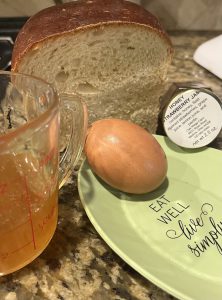

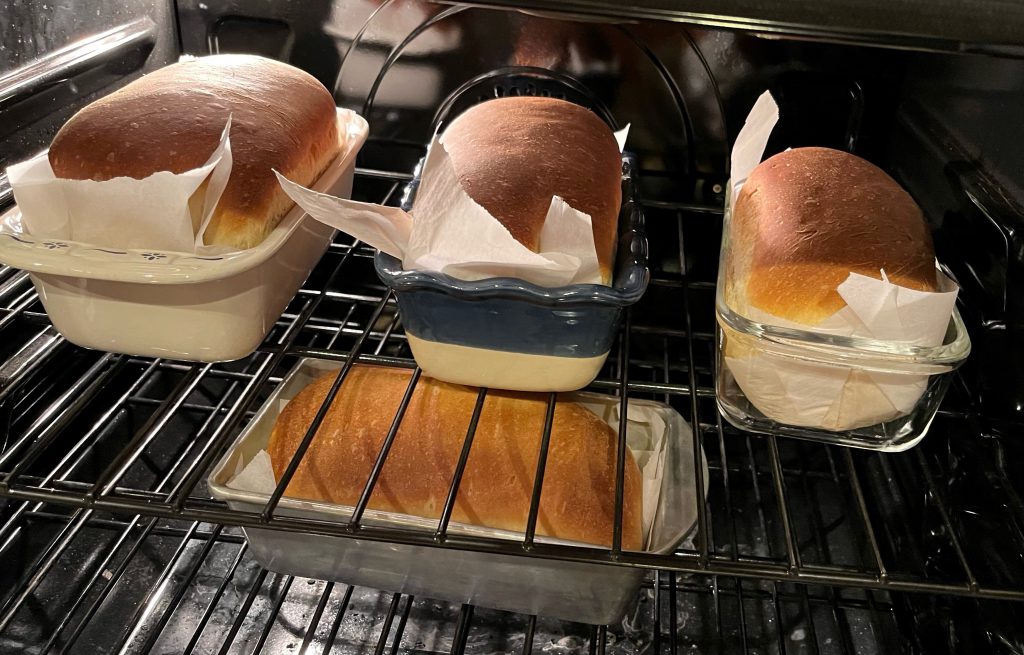
By: Becky Masterman & Bridget Mendel
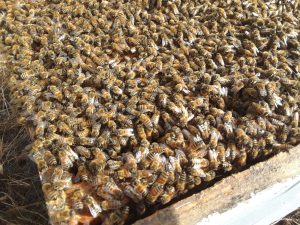
Successful beekeepers track numbers throughout their colonies and apiaries over time. Knowing varroa mite loads might help explain colony death. Honey production yields can reflect habitat quality around your apiaries. Photo credit: Rebecca Masterman
Managing bees is kind of a numbers game. Not in the illegal gambling sense, but instead in the measuring bee health and business sense. New beekeepers are warned about the importance of counting varroa mite numbers in their colonies and hear stories about high percentages of colony loss. Long time beekeepers and many commercial operations remember stories of high honey yields and market prices that are impacted by imports. Whether you are new to beekeeping or a long-time participant, keeping track of key numbers could be good for you, the bees and beekeeping.
It has been said often that beekeeping is local, so your beekeeping numbers should be too. Honey yields per colony vary greatly from state to state (and apiary to apiary within a state and hive to hive within an apiary) as do the pounds of honey that bees need to get through Winter or dearth periods. Tracking key numbers within your state each year can serve as a bee health conversation starter. Let’s hope that the conversations continue each year and are about lower colony losses and higher honey yields.
Here are some numbers that we think are important.
Varroa Mite Loads
Let’s get the mite talk out of the way and address it right away. Varroa mites and the viruses they vector are still one of the greatest threats to the health of your honey bee colonies. Successful beekeepers keep on top of the latest management recommendations and know the threshold where intervention is key to maintaining healthy bees. This threshold might be different than what you think and the threshold changes depending on the time of year. Monitoring mite loads is important. Keeping up on the latest research-based recommendations is also critical to successful beekeeping as your management will change over the years as the threats to your bees change (anyone remember tracheal mites?). This excellent update from the Bee Informed Partnership will bring you up to date on mites as well as provide a link to the latest free edition of Tools for Varroa Management from the Honey Bee Health Coalition. While you are there, we suggest signing up for updates from the Bee Informed Partnership (https://beeinformed.org/2023/03/01/the-importance-of-spring-mite-loads).
Colony Loss Data
Let’s also get the colony loss data out of the way. Following significant colony losses across the U.S. in 2006, the Bee Informed Partnership has been tracking colony losses across the U.S. You can contribute to the survey each year in April by reporting your losses. Reported loss data by states is available all the way back to 2008 (https://research.beeinformed.org/loss-map/).
Honey Market Numbers
The National Honey Board compiles honey data from multiple sources on their website and you can easily spend some time looking at the numbers (https://honey.com/honey-industry/market-overview). For a monthly regional report, Bee Culture’s detailed guide will provide everything you need to know (https://www.beeculture.com/monthly-regional-honey-price-report/).
Honey Yields
If you want to explore your state honey data, the USDA National Agricultural Statistics Service has a searchable database for all things honey and bees, including reported honey yield per colony. You can search national as well as state data across more than 30 years (https://quickstats.nass.usda.gov/).
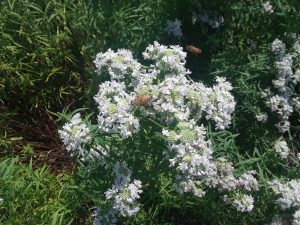
Measuring available habitat for your bees is difficult but doing so might inspire others to increase floral resources for pollinators. These bees are enjoying the blooming mountain mint planted in the apiary. Photo credit: Rebecca Masterman
Because honey bees are managed pollinators, it is easier to track the numbers described before. One other number that is more difficult to track, yet very important, when talking about honey bee health is Acres of Pollinator Habitat.
How much pollinator habitat is available for bees in your state? It is a difficult number to track as counting the flowers on trees, shrubs, prairies, conservation land, cover crops and more (bee lawns, gardens, roadside habitat, etc.) is not easy, but we love those who are trying to do just that. Please visit Homegrown National Park’s website and spend some time appreciating their efforts to support grassroots conservation with a way for all of us to map our native plantings (https://map.homegrownnationalpark.org/Dashboard/Country).
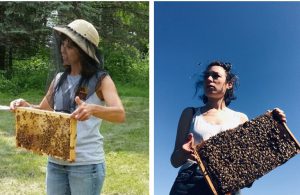
Becky Masterman led the UMN Bee Squad from 2013-2019. Bridget Mendel joined the Bee Squad in 2013 and has led the program since 2020. Photos of Becky (left) and Bridget (right) looking for their respective hives. If you would like to contact the authors with your number stories or thoughts, please send an email to [email protected].
Knowing the status of food for your bees is important. Beekeepers usually work backwards, as they place their bees and measure the honey. If honey production is low (compare yours to the average honey yield), then it is possible that there are not adequate resources for your bees. If honey production is high, then you are in luck. If you planted flowers specifically for your bees to make honey on, then it isn’t luck, but good planning.
Should we be measuring some of the pollinator habitat in our states? We think it is a great idea and good to know if the numbers are going up or down. Some numbers, like acres planted in CP42 Pollinator Mix in the Conservation Reserve Program are being measured. Is it possible for state or federal agencies to keep track of the habitat they have installed without too much of a record-keeping burden? We don’t know but think we should ask.
Acknowledgments and suggestions:
The authors would like to thank Dr. Marla Spivak for helpful edits and suggestions.
New(ish) Beekeeper Column
By: Richard Wahl
As late Spring moves into Summer and the bee numbers in the hive begin to increase, it is not unusual to have a hive release a swarm. I have seen swarms in our area of SE Michigan begin in mid-May and continue as late as late August. The most frequent occurrence of swarms seems to occur from early June to late July. During my first few years of beekeeping, I would have insisted that these swarms were not coming from my hives. As I have become more aware of the causes for swarming I now believe that in those early years that at least some of the swarms I was catching did indeed come from my hives. But what would cause this natural tendency to swarm and how can it be minimized? The most probable cause for a hive to swarm is overcrowding. Although I knew some of my earlier year hives were strong and felt they had not swarmed, I have now changed my opinion on this point. Just because there still seem to be a lot of bees in the hive after a swarm is not a good indication that the hive did not swarm. An overcrowded hive after a swarm may look, to the new beekeeper, very similar to the pre-swarmed hive even though ⅓ to ½ of the hive may have departed. If a hive is not examined the day before and the day after a swarm it will be very hard to tell if the hive has swarmed. As the hive begins its late Spring and early Summer build-up it experiences a large population increase. By late June or early July, this huge increase may be the precursor to a swarm. If something is not done to preclude this there could be a loss of a significant honey crop later in the season. This is because it has been found that up to 75% of the hive foragers may leave with the swarm. This large decrease in the bees that have reached the forager stage leaves most of the new bees to still go through the nurse bee and internal hive job stages before becoming foragers. This makes sense, since the swarm needs foragers to supply the nectar needs and comb building of a new hive while the bees remaining in the original hive serve as nurse and house bees to support the care of newly emerging bees before becoming foragers. I once had the privilege/misfortune to watch a swarm emanate from a hive and it is an exhilarating and exciting sight to see and at the same time very disappointing. I was about to inspect my hives around 11:30 in the morning. As I was inspecting my most western hive, there seemed to be a lot of activity at the hive entrance of the next hive over. I initially chalked this up to orientation flights as these also exhibit a lot of activity in front of the hive for a short time. But suddenly there was a massive exodus of bees from that next hive as wave after wave of bees marched out the reduced hive entrance and circled around the calm air in a thirty to forty foot circle in front of my hives. After about ten to fifteen minutes the bees coalesced into about a five to six foot diameter circle and departed to the south about ten to twelve feet off the ground never to be seen again. I checked the hive and there were still many bees present. Had I not seen the swarm depart with my own eyes, I would have been none the wiser that this hive had swarmed. It was then I realized some of my earlier year swarms may have been from my own hives. The propensity to swarm is not to be viewed as a bad thing as it indicates the hive was strong to begin with. Hopefully, it will regain its strength as it rebuilds, although this can be a time consuming process. Before I get into some steps that can mitigate a swarm, there are a few other conditions that may be reasons for swarming.
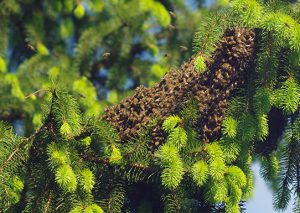
A captured swarm from a backyard pine tree began my beekeeping adventure with no previous knowledge or equipment.
Reasons for Swarming
In addition to the crowding previously mentioned, swarming may also occur due to a heavy mite infestation. As the bee population increases, the potential for mite increase is also present due to the availability of many more capped brood cells in which to reproduce. If the mite population gets out of hand, the bees could decide to swarm to find a better location only taking the phoretic mites with them. Phoretic mites are those riding around on the bee’s backs or thoraxes. Mites in un-emerged cells will be left behind in the hive. Not initiating some type of mite mitigating protocol on one’s hives is the greatest reason for hive losses. Likewise, some method of mite treatment management should take place with a captured swarm to assist the success of that swam in becoming a productive hive.
As mentioned before, not enough space can be a reason for swarming. This is not only true for the crowded double deep hive, but can also happen in as small as a three frame nuc. Small three to five frame nucs need to be watched much more carefully and given added space sooner to preclude the possibility of all frames being filled with nectar and brood almost requiring the nuc to swarm if there is not enough room for more eggs and brood or honey storage space. Over time, brood frames become old and minimally smaller with the pupae cocoons of repeatedly raised new brood in those cells. Additionally, those continually reused cells may retain slight bits of the agrochemicals used in pesticides, which leads to near universal contamination of beeswax in the bee colony. Wax contaminated with these pesticides negatively affects the reproductive quality of queens, drones and the overall quality of worker bees. When the bee’s tolerance of the contaminants in the reused wax brood cells exceeds an unknown threshold the bees may decide to swarm. Therefore, it is a good idea to replace old brood foundation with new frames on a regular basis. I have read that every four to five years is a good time allowance for replacing brood frames but have also seen some respected beekeeper researchers let this reach to an eight to ten year replacement cycle.
Another reason for swarming is the internal hive climate. If the temperature is continually getting too hot or the bees do not have the capability to provide proper ventilation, this may also induce swarming. The bees spend a great deal of effort keeping the internal humidity and temperature at the ideal state around the queen, brood and nectar stores. If drainage or ventilation needs become too severe the bees could decide to swarm.
Yet another reason for the hive to swarm is that there is a problem with the current queen. She may simply have exhausted her ability to lay or fertilize eggs and the hive senses it is time to move on with a new queen.
One final reason for swarming is that it is a natural tendency for all living things to have a propensity for procreation. The simple desire to continue ones genetic stock in future generations can best be accomplished by Apis mellifera with swarming. This inherent drive is almost impossible to identify in order to preclude a swarm by even more experienced beekeepers.
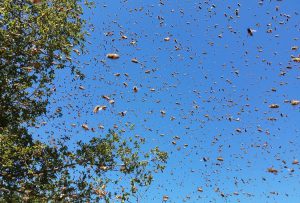
A swarm in flight getting ready to depart the hive area.
Swarming Symptoms
There are a few things the beekeeper can look for in hive inspections that may indicate a precursor to a hive’s potential for swarming. That first, late Spring hive inspection becomes very important in determining a hive’s swarm probability. We all hope for a strong cluster to survive the Winter and become a thriving hive as the first nectar flow begins. If within a month of that first strong hive inspection and there are more than five to seven frames of brood in a double deep Langstroth hive, then it is most likely time to do something to manage that hive. I have found that adding another brood deep or honey super when all but the last frame or two are filled results in a less likely potential for swarming with first time overwintered hives.
The presence of open, unused queen cups along the bottom of frames is normally nothing to be concerned about. These are usually only present for an emergency response if needed. But if those cells become fully developed queen cells, or start to contain larva, the hive may already have decided to swarm.
Significantly reduced activity can be a sign of potential swarming as bees are not bringing much into the hive. This can be hard to ascertain by the new beekeeper and may be caused by lack of space for more nectar or pollen brought into the hive. I find I often need to remove a frame or two of older pollen filled frames as there is such a wealth of pollen sources here in SE Michigan. Often, more frames than needed become nearly saturated with pollen using up valuable space for more brood or nectar stores.
Another indication that a hive is getting ready to swarm is that the hive has had no weight gain in a week or so period. I have to admit that I do not monitor my hive’s weights until the early Winter weight check, if at all. But research has shown that if a hive does not gain much weight during a nectar flow week, it is almost a sure sign of swarm preparation to come. As I became more experienced as a beekeeper, I found that more careful monitoring of my hives could give a good indication of swarming potential. From there I have found that splitting a strong hive early on is the best way to avoid the swarming instinct. In a previous article, I went into the elements of how to split a hive so I will not repeat those steps here.
Mitigating a Swarm
There is a lot written about removing queen cups to preclude the swarming instinct. The thing to remember is that by removing queen cups you are not changing the bee’s instinct to swarm if it already exists. The bees can build new queen cups in a matter of days so removal must be a continual process every two to three days, not an objective most beekeepers prefer to try. The destruction of queen cells has never proven to be a successful method of swarm control. I have seen eggs laid in cells for worker bees that appear to be only ⅓ of their final size. The bees continue to build the cells even as the egg and larva begin to grow. The bees may use this same technique for new queen cells and if an unfound queen cell that was missed emerges the hive may swarm earlier in the normal development of the replacement queen. Destroying queen cells on a second try runs the risk of early swarming and no new queen left for the remaining hive to develop. This could also result in the initial swarm being even larger than if you had not interfered with the removal of queen cells.
The best way to curtail the possibility of swarms is to do a split as soon as a hive is perceived to have swarm characteristics or seems strong enough for a split. A split is actually akin to creating an artificial swarm and the best known way to minimize the possibility of swarming. If developed queen cells or queen cups containing larva are found, these are perfect frames to move to starter nucleus (nuc) hives. A year ago, I split all six of my hives that came through Winter in a strong state with plenty of bees in each. That is the first time that I did not see or catch any swarms during that following Summer. Even if the hobby beekeeper does not desire to increase their hive count with splits, there is plenty of interest among new beekeepers to purchase nuc hives. Or the beekeeper could marry the queenless part of a split to another weaker hive in the apiary.
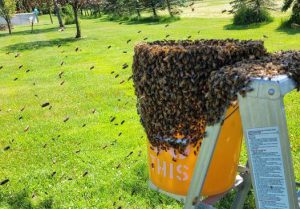
The swarm gathers around the queen in or on a bucket.
Capturing a Swarm
The capture of a swarm may be as simple as shaking them into a hive from a hanging branch or have the complexity of extracting them from an enclosed building cavity. When a queen leaves a hive with a swarm she usually will land within 100 feet or so of the originating hive. Most of my early swarm catches have been within several 100 feet of my own hives. This might be an indication that they were coming from my hives. Although six large swarms within about two weeks coming from the only two hives I had one Summer seems a bit implausible.
Bees surround the queen to keep her warm, dry and safe until scouts find a new location for their new home. This could be any sort of building or tree hollow that the scouts agree upon. Although a swarm can be intimidating in appearance, they have engorged themselves on honey before leaving the hive and have no eggs, brood or stores to protect. As a result the swarm is relatively unlikely to sting and can be quite docile. The one reason bees tend to sting is if some are getting squeezed or feel threatened. The swarm may move off in a matter of hours or stay in the initial swarm location for several days depending on weather and how soon the scouts find a new home. So it is wise to capture a swarm as soon as possible to avoid their eminent departure.
The steps to capture a swarm are relatively easy. It is advisable to wear a bee suit and veil as the disturbance of the swarm may be enough to make them feel threatened. You will need some sort of container for transport, if it is not convenient to drop them directly into a new hive. A five gallon bucket will work well, particularly if it has a ventilation screen on the top or a cardboard box with ventilation screened holes in a few spots works equally as well. Once the container is under the bee swarm, a quick shake will drop nearly all into the container. I have seen a five gallon bucket fastened on the bottom of a ten foot pole that was used to reach a swarm a bit higher in a tree. Shaking the branch caused most bees to drop into the bucket. If they are on a non-shakable surface a bee brush may be necessary to gently sweep them into the container. Some beekeepers like to spread a bedsheet or tarp under the spot where the bees will drop to better contain those falling outside the container. If the queen fell into the container, most of the remaining bees will join her. If she has not gotten into the container, the bees will return to her and reform a new cluster around her location following her queen pheromones. You will need to give them a little time to resettle down after which the process can be attempted again. If able, leave the container sit until nightfall or dusk to give the remaining bees time to congregate in and around the container. After dark, the bees will have settled down and the ventilated container can be closed and taken to the new hive location. Within a day, they should be moved into their new hive. If you are not interested in capturing a swarm there are eager beekeepers that can likely be contacted through local clubs, government Ag or environmental agencies who will come to get the bees. Feral swarms are most desirable because they are genetically suited to the local area and tend to be less disease prone than those raised in the hundreds by commercial apiaries which are shipped as packages to beekeepers.
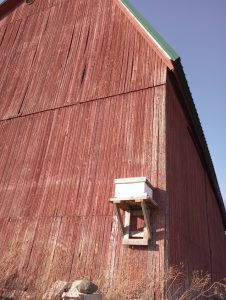
A ten frame deep on a barn mounted platform used as a swarm trap just prior to strap down.
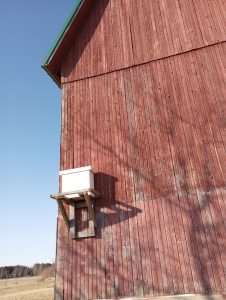
A 40 liter swarm trap mounted on a barn stand just prior to strap down.
Swarm Traps
I have made it a practice to set out a swarm trap or two early in each season of beekeeping. I have attached two hive stands to the rear of a hip roof barn at about eight feet off the ground. A bit higher would be nice but that is the height of an inner beam that made a good attachment point. Nearly every Summer, I have had a swarm move into one of these traps. On occasion, I have simply set a single ten frame deep hive on a stand and occasionally a swarm moves into it. I think the empty drawn comb frames inside are a good draw for the swarm. My homemade swarm traps hold five deep frames with another five or six inch open space below the frames. Research has shown that 40 liters of space seems to be the ideal to draw in a swarm. The open space below, along with the five frames, works out to almost exactly 40 liters. In addition to the five drawn comb frames, I will add a plastic perforated baggy at the bottom with an inner paper towel that had some lemongrass essential oil drops added to it.
The plastic baggy is perforated in a dozen spots by poking a sewing needle through the baggy. Only a few drops are necessary and this seems to attract bees that are in a swarm state. My most unusual swarm catch occurred one Summer when I failed to remove an empty hive to storage. Sitting in the middle of my row of hives I had left it there for the other bees to clean out, a small bit of the remaining honey still inside. Every so often I checked it to see that no hive beetles or wax moths had moved in, but always failed to move it to storage. One day, I noticed bees carrying pollen into the hive which I thought a bit unusual for an empty hive. Come to find out, the bees coming and going, which I thought were just gathering the remaining honey, were actually a swarm that had moved in with a new queen that was laying a nice pattern of eggs and already had larva in surrounding comb. Nothing seemed to be missing from any of my other hives. That hive is now coming into its third year and still seems strong.
So, by managing your strong overwintered hives with splits and observance, you may be able to avoid losing much of your bee population to swarms. Use an increase in hive space and/or splits as a swarm management tool to increase your hive count and/or nuc resources for personal use or sell-able nucs. Your swarm experience could vary based on your conditions, environment or state of your overwintered hives.
]]>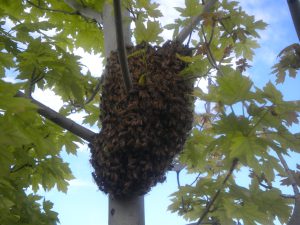 It might be tempting to think that it is all right not to worry about whether colonies are going to swarm, since swarming is a natural thing that honey bees do. In fact, we know that our colonies need to swarm to help keep mite numbers low, besides the need to keep colony numbers up. They are, in a way, working to replace colony losses before they occur, in the same way we humans do. Many urban backyard beekeepers are happy with their two colonies, and don’t want more, so they would rather let the swarm hit the trees than split and deal with excess colonies. There is also the hard fact that splitting intimidates newer beekeepers. There are some significant negatives to this strategy, however.
It might be tempting to think that it is all right not to worry about whether colonies are going to swarm, since swarming is a natural thing that honey bees do. In fact, we know that our colonies need to swarm to help keep mite numbers low, besides the need to keep colony numbers up. They are, in a way, working to replace colony losses before they occur, in the same way we humans do. Many urban backyard beekeepers are happy with their two colonies, and don’t want more, so they would rather let the swarm hit the trees than split and deal with excess colonies. There is also the hard fact that splitting intimidates newer beekeepers. There are some significant negatives to this strategy, however.
For one, when a swarm leaves a colony, it will usually find a home within flight range of the parent colony. The bees and mites increase in number until Fall, when, without your help with Integrated Pest Management or treatment, it collapses, your bees rob the failing colony and bring the mite load home, and they die, too. You have seeded your very own mite bomb. Or maybe, your bees are the perfect, mite resistant bees, so you don’t have to worry about that. They just move into your neighbor’s attic, it costs him $350 to have them removed, and you and your bees have earned an enemy. Or maybe, the swarming bees only take your honey production and pollination work force with them. Allowing colonies to swarm isn’t a very good way to help honey bee numbers overall, since only 8% to 24% of swarms survive the first Winter(1). The bottom line: it is important to control swarming.
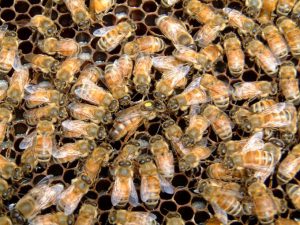
The queen with her retinue. As they feed and touch her, they pick up her pheromones and pass them throughout the colony. Amazingly, all 60,000 bees know she is gone with 15 minutes, usually, and will begin keening for her.
Photo credit: Tina Sebestyen
The good news is that if you want to have all the benefits of a swarm, without any of the disadvantages, there are ways to control it. The best, for sure way to control swarming is splitting. Even a simple split; three frames of brood, and one of food, with the bees that are on them with the old queen is probably the best. This mimics a swarm, the old queen leaves the colony with some of the bees (but this way, far fewer than would have gone in a natural swarm). You can sell the nuc that you have just created so that you don’t end up with extra bees, and help provide local bees for your area. But still, people sometimes don’t want to make even this simple split (usually because they can’t find their queen, we’ll solve that problem later in this article). There are other ways to control swarming without splitting, though some of them may be more work than the split would have been.
One of the reasons that swarms happen when they do is that the queen’s pheromones (QMP) are not very volatile, meaning they aren’t spread in the air so much. Rather, they are spread by touch. The bees in the queen’s retinue pick up the chemicals from her (her pheromones) as they feed her, antennaete her, touch her with their feet and lick her, and they then pass these chemicals from one bee to the next, so that all of the bees in the colony know that the queen is present. As the queen ages, her pheromones become weaker, and as they are spread throughout the colony, everyone gets a smaller portion. The crowded conditions in a Springtime colony mean that the pheromones get spread even further, and this triggers the swarming instinct in the bees. Young queens have much greater amounts of QMP, and this helps keep the colony from wanting to swarm. So, replacing the old queen (one that has been through even one previous Spring build-up) with a young, well-mated queen can help control the swarm tendency. Re-queening alone will not be enough, even a young queen will swarm when the brood nest is congested. It is definitely important to ensure that there is a lot of space for the queen to lay eggs. Making sure that there is someplace else to store honey is critical. Supers must be added before nest congestion even begins.
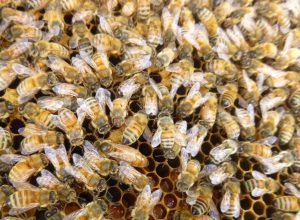
The queen pushes through bees on the comb while leaving a wake behind her. This works best when the comb is solid with bees, and there are fewer random spaces on the comb. Photo credit: Tina Sebestyen
Controlling swarming is more work with an older queen. It may be necessary to remove most or all of the brood from the area the queen can access. One way to do this is just to confine the queen to a box of only frames with foundation and two frames of emerging brood, using a queen excluder. It will take time for the bees to draw comb for the queen to lay eggs in, thus creating a small brood break. Full honey supers function very effectively to limit movement of bees, thus creating the same conditions that would be felt after a swarm had already occurred. Emerging brood can be moved to the top of the stack (or behind the other bars or frames in horizontal beekeeping). Once the young bees emerge, the comb is ready for honey. Separating the queen from capped brood is a very effective swarm control strategy.
Or, frames of open brood can be moved up, and they will attract many of the nurse bees, thus relieving crowding around the queen (this is called the Demaree method)(2). The separation of open brood from the queen and the distance created by the full honey supers causes nurse bees to start queen cells. These must be killed or moved to mating nucs, and the now-capped brood in the upper chamber moved down while eggs and young larvae from the queen’s box must be moved up after seven to nine days. It may be necessary to do this rotation twice during the honey flow to keep the swarm instinct under control. Another idea is to leave one queen cell in the upper box, which should have an exit facing in a different direction than the main entrance below. The virgin queen will hopefully mate and return to the upper hive body, and now you have a very, very efficient honey producing colony with two queens and a huge work force. After the main honey flow, the old queen can be culled, leaving the young new queen to head the colony.
Re-queening a colony in July is a very effective way to ensure that when Spring arrives, swarm control will be simpler, since this queen has never been through a Spring build up and has good, strong pheromones. Two other benefits to mid-Summer re-queening are greater numbers of fat Winter bees and a good brood break for mite reduction. Colonies with young queens raise 3,000 more fat Winter bees than colonies headed by older queens(3). These bees are better able to survive Winter, produce heat, conserve honey use and feed brood in early Spring. And since the brood break created while the colony raises a new queen in mid-Summer means that all of the brood has emerged, the brood break can be combined with an oxalic acid mite treatment. This is a most effective heat-of-Summer mite reduction when many other treatments cannot be used due to temperature thresholds. When the young queen begins laying eggs (do the math so that this is early enough to raise two brood cycles, or 42 days before it freezes), mite counts will be low, and you have protected your fat Winter bees from them and the diseases they carry.
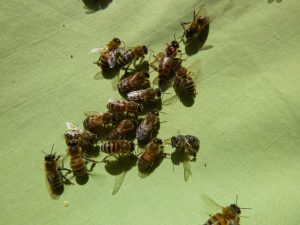
No queen excluder? Just shake the bees in front of the hive on a pillowcase (not a towel, it catches their feet) and as they spread out and walk in, you can catch your queen. Photo credit: Tina Sebestyen
You may have noticed that all of these strategies for reducing or attempting to manage the swarming instinct require movement of or removal of the queen. The main reason people don’t want to do splits in the first place is because they don’t know how to find the queen. Admittedly, even seasoned beekeepers may find it a challenge to locate a queen in a super-full, swarm-ready colony. Because this is a skill that should be honed, let’s start out by looking for her.
Tricks to help in finding the queen
First, if you want to find the queen, you want her to continue doing what she was doing, which means not smoking the colony before opening it up. In Spring, the bees are happy and non-defensive, so smoke is probably not needed anyway, unless it is a very defensive colony, in which case it is even more important to find that old queen! If you must smoke, then do it, but try to find her without smoking, if possible. Remove the honey supers and set them aside after you have ascertained that there is no brood in them.
As you expose the top of each brood box, look at the bees on the tops of the frames. If it is the box with the queen in it, there will be a five inch circle where the bees are more concentrated than elsewhere. The queen is under this circle of bees. Remove the outer frame to create room to work, then push all of the frames at once away from the one you suspect may contain the queen. Working quickly will help in finding the queen, since the light coming in will make her want to run. Remove the frame that was in the center of the circle of bees, and, rather than looking for the queen, look at the whole frame. Hold it at arm’s length and let your eyes take a snapshot of its entirety. You are looking at the pattern of bees on the frame. There will be bees facing in every direction and going about their business. But, if the queen is stationary, her retinue will be in a circle around her, caring for her. If she is in motion (which she probably will be) she must push her way through the crowds of bees, but behind her there will be a bare space on the comb, a wake like would be behind a boat on an algae-covered pond. This works best in a super-full colony, just what we have in Spring.
Once you see either a circle of bees, or a bare spot on the comb, now look for the queen. Her big, bald thorax is a good clue. Of course, drones have big thoraxes, too, but they are usually still fuzzy. The queen’s is bare because as she measures each cell to know if it is for a drone or for a worker, she rubs the back of her thorax, and that makes it bald(4). Now that you have found her, you need to be ready to capture her. Lay your hive tool on the tops of the frames to act as a stand for the frame, and set the top bar of the frame on the hive tool, this frees up your two hands, and helps keep the frame from crushing the bees on the backside of it.
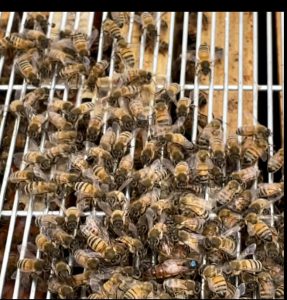
Using a queen excluder to find the queen is fairly fool-proof, if you are careful to shake every comb and every box as you go. Keep in mind, if you don’t find the queen this way, there may not bee one present (the colony may have swarmed already and there is a virgin in the hive, who may be able to cross an excluder). If you find recently emerged queen cells, don’t be looking for the queen! It is much too disruptive, and you may cause the bees to kill their own, brand new queen if you go looking for her less than two weeks after she emerges.
Photo credit: Tina Sebestyen
A queen catcher is a nice thing to have, and I keep one in my pocket at all times. Even better, in this situation, is to pick up the queen with your fingers and put her in a queen cage, then hold your index finger over the hole. Once you get her inside, look at the frame you just set down and find a bee with just its butt peeking out of a cell. This is a nurse bee who is feeding larvae, and she will be able to feed your queen, too. When she backs out of the cell, pick her up by her wings and put her in the cage with the queen. Find four or five of these young nurse bees, and put them all in with the queen. If you don’t have the patience to carefully choose nurse bees this way, at least pick young, fuzzy bees, but not newly emerged ones. They need to be at least five days old to have developed hypo-pharyngeal glands for royal jelly production.
Now, you can do whatever you like with this queen. I almost never pinch a queen, unless there is something major wrong with her. Placing her in a cage with four or five nurse bees gives you a week to decide what to do with her. It might be nice to make a small nuc to support her. If your colony will be making their own new queen, there is a 20% chance that she won’t make it back from her mating flight, so it is nice to have the old one in the bank. If you have bought a queen for replacement, there is still the chance you’ll need this old one, or you can sell her to someone who is desperate and is dealing with a less-than-ideal situation (no brood, laying workers, etc.)
The other way to find a queen, and what you can do if you look for yours and can’t find her, is to employ a queen excluder. Since queens can’t normally cross through a queen excluder, it is possible to find her using one.
First, set all of the boxes aside, away from the bottom board, and a few feet from one another. In just a few minutes, the boxes that do not have the queen will begin keening for her. It is a sound like no other in beekeeping, and once you hear it, you’ll always know what it means. The box that is quiet is the one with the queen (the bees can be a little tricky about this, it is a clue to her location, not a fact).
Set a new hive body on the bottom board, or take all of the frames out of a box and set them carefully where they will be safe. Shake the bees off of the side walls into another box and set the empty one on the bottom board, with the queen excluder atop it. Now, take each frame and shake the bees off of it, over the queen excluder. The worker bees will begin passing through, leaving the queen behind for you to capture. If the bees don’t want to go down, you can push them down with a little smoke. Once enough of the bees have passed through to see that the queen was not on that frame, lift the excluder a bit and put the frame into the box. Pick up the next frame, shake it, look for the queen, place the frame in the box. Continue until the queen shows up on the excluder, remembering to shake the bees off of the side walls of hive bodies, and even out of the honey supers until she is found. This method takes no particular skill, nothing but time and patience. You do need to be able to handle the queen once you’ve found her, so practice on drones until you get really good at catching them by their thorax alone, without touching their abdomens. Go ahead and mark them while you’ve got them, for practice. Practice makes perfect, just like our moms said, and beekeeper experience is a leading indicator of colony survival.
Rangel, J., Seeley, T.D. Colony fissioning in honey bees: size and significance of the swarm fraction. Insect. Soc. 59, 453–462 (2012). https://doi.org/10.1007/s00040-012-0239-5
Caron, Dewey and Connor, Lawrence, Honey Bee Biology and Beekeeping, 3rd Edition, pg. 281, (2022) Wicwas Press
J. Lloyd Harris (2008) Effect of requeening on Fall populations of honey bees on the northern Great Plains of North America, Journal of Apicultural Research, 47:4, 271-280, DOI:10.1080/00218839.2008.11101474
Kearney, Hilary QueenSpotting, Meet the Remarkable Queen Bee and Discover the Drama at the Heart of the Hive (2019). Storey Publishing
In 2008, I began making beekeeping videos on YouTube. At first, it was only a way for me to share what I was learning. Over the years, I have learned to enjoy sharing beekeeping especially with new beginners and one way is by helping beekeepers learn to enjoy inspecting their bees. Over the years I have gathered a wealth of knowledge on the common difficulties, mistakes and inquiries that beekeepers encounter during hive inspections. I’ve taken this information and have simplified key elements to a productive hive inspection.
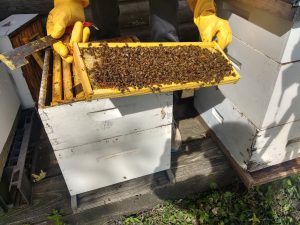 1. Plan the Frequency of Your Inspections
1. Plan the Frequency of Your Inspections
Typically, inspecting your bees twice a month is sufficient, with one of these inspections being brief and focused on specific aspects, such as the queen’s productivity and the need for additional space. This focused inspection should take no more than ten minutes. The second inspection can be conducted two weeks later, during which you can devote more time to observing potential issues. By striking the right balance and tailoring your inspections to the needs of your hive, you can ensure the health and productivity of your bees without causing undue stress or harm.
2. Bring Focus & Specifics to Each Inspection: The Brief Inspection
To ensure an efficient and productive hive inspection, it is crucial to have a well-defined plan in place. Instead of attempting to inspect all twenty or thirty frames, identify specific elements to focus on during an inspection. For instance, you may prioritize a mite inspection or assess your queen’s productivity. This allows you to streamline your inspection and reduce its duration significantly. Not only will this approach be more enjoyable for you, but it will also be less disruptive for your bees. Ultimately, having a clear plan and defined objectives for each inspection can save you time and effort, while helping you achieve the desired outcomes.
Another single focus inspection may be to evaluate the need to add boxes. It’s crucial to assess whether the colony has sufficient room to expand and grow. As a rule of thumb, when one box is filled with five to seven frames of drawn comb, it’s time to add the next brood box or super. This ensures that the bees have ample room to continue building and developing their colony, ultimately promoting a healthy and productive hive. By keeping a close eye on the space requirements of your hive and making adjustments as necessary, you can help your bees thrive and prosper.
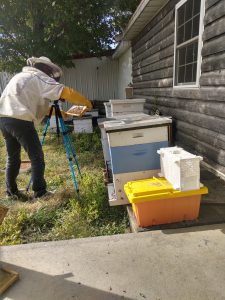 3. Learn To Spot Trouble Quickly & Simply: A More Thorough Inspection
3. Learn To Spot Trouble Quickly & Simply: A More Thorough Inspection
Discovering issues within our colony, such as a mite infestation or disease, is something that no beekeeper wants to encounter. However, it’s crucial to remain vigilant and not let our reluctance to confront problems impede our ability to identify them. For instance, when I inquire about mite counts, I often hear responses like, “I didn’t see any,” which may indicate a subconscious reluctance to detect any potential issues.
A thorough inspection should take place every four to six weeks, dedicated to observing critical issues such as pests and diseases. When conducting this inspection, the first pest you should be on the lookout for is the small hive beetle. As soon as you lift the top, these pests will scatter and can typically be found on the top cover or the tops of frames. Be sure to take notice of their presence, and if you spot an alarming number, it’s time to take action by placing beetle traps between the frames. These traps can help slow down and contain your beetle problem, ensuring that your hive remains healthy and protected.
As you make your way to the brood frames a quick inspection of the open brood can quickly reveal any issues. The larvae should be swimming in a glistening pool of royal jelly and each larvae should be pearly white in color. The bacterial brood disease, European foulbrood, causes the larvae to be discolored, darkened and their spericals to be visible. From just a ten second glance of the larvae, this problem can be diagnosed.
Moving on, take a moment to observe the capped brood – the sealed pupae can provide valuable insights into the health of the brood and the queen. Healthy brood should appear smooth and even, with very few empty cells. This is known as a solid brood pattern and is a positive indication of a thriving hive. However, American foulbrood – another bacterial brood disease – can cause sunken and perforated brood, often accompanied by a foul odor. Keep a sharp eye out for any signs of irregularities, as early detection can be critical in preventing the spread of disease and preserving the health of your colony.
I have a video you may enjoy on YouTube that may help you enjoy your inspections and be better able to assess the condition of your colony.
How To Inspect & Evaluate Your Hive: https://youtu.be/iEEhkJ2Qzx0 or go to YouTube and search for “David Burns Beekeeping.”
Beekeeping can be a rewarding and fascinating hobby, but it also requires careful attention and diligent management to ensure the health and productivity of your bees. By following a few simple guidelines and adopting a focused and well-defined approach to hive inspections, you can minimize disruption, avoid harm to your bees and quickly detect any potential issues before they become more significant problems.
]]>By: Michael Johnston
Strangely enough, it is not intuitive to most beekeepers that soil types are extremely important to how well their beehives will produce honey as well as what types of honey will be produced. Our expectations of honey crops depend upon our own past experience or a verbal legacy passed down from more experienced beekeepers.
Beekeeping is a form of agriculture. While it is obvious to all of us that soil fertility and pH are vitally important to field crop production, we often do not make the connection that beekeepers are producing a crop dependent upon plants that either will or will not thrive depending upon the soil in which they are grown. I suspect that if our job as beekeepers was more involved with the production of honey plants rather than the production of bees, the connection between soils and honey crops would be more obvious.
In the literature on beekeeping, you do see references to the importance of soils in apiculture. One such book, Honey Plants of North America written by John H. Lovell and published in 1926 does identify the importance of soils in beekeeping.
Mr. Lovell states “Plants growing in soils to which they are adapted are more vigorous and produce more nectar than in soils in which they do not flourish.” In his section on New York State, Lovell says “New York well illustrates the importance of a knowledge of soil properties not only to the farmer but to the beekeeper as well.”
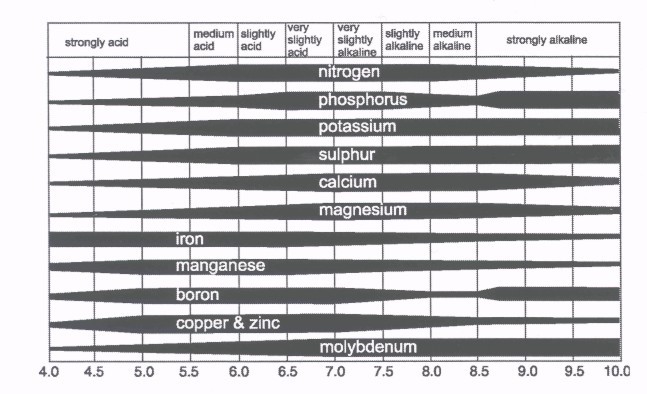
Chart of the Effect of Soil pH on Nutrient Availability
Soil fertility, the availability of needed plant nutrients, will lead to more vigorous plants. Natural soil fertility is dependent upon texture, organic matter, pH, soil depth and the parent material from which soil is derived. The pH of a soil is directly related to the availability of soil nutrients to plants. The term pH refers to the proportion of hydrogen ions (H positive) and hydroxyl ions (OH negative) in water (H2O) solution. The measurement scale for pH is logarithmic and goes from zero to 14 with seven being neutral. Soils with a pH under seven are acid and hydrogen ions are predominate and soils over seven pH are basic and hydroxyl ions are predominate. Most soils are acid and can be described as follows:
- 6.5 to 7.2 – slightly acid to slightly alkaline
- 5.5 to 6.5 – moderately acid
- 5.5 and below – very strongly acid
A pH between six and seven correlates to the greatest availability of nutrients in soil solution. Nitrogen is most readily available in soils greater than 5.5 while phosphorus, potassium, calcium and magnesium are more readily available in soils with a pH greater than 6.0. Molybdenum is very unavailable in acid soils and becomes readily available in soils with a pH greater than 6.5. Molybdenum is particularly important to growth of plants in the legume family. When the pH goes above 7.0, the availability of phosphorus, zinc and copper decline rapidly. Iron and manganese are necessary micronutrients for plant growth but when the pH of soil drops below 5.5, there can be so much of these nutrients as well as aluminum in solution that they actually become toxic to many plants.
In Honey Plants of North America, John Lovell separates honey plants into two great groups: Calciphiles (lime lovers) – plants which grow best in limestone (sweet) soils with a relatively high pH and Calciphobes – plants which avoid lime soils and grow best in acid (sour) soils. In regard to the calciphiles, he further states some plants grow in high lime soils only, while some prefer lime soils but will grow in other soils. Similarly with the calciphobes, some plants will grow in acid soils only, but some prefer acid soils but will grow in other soils. There are still other honey plants that will yield on a wide range of the pH scale. We will review some examples of all of these groups.
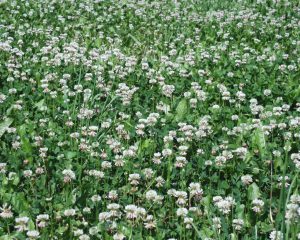
White Clover (Photo by Peter Borst)
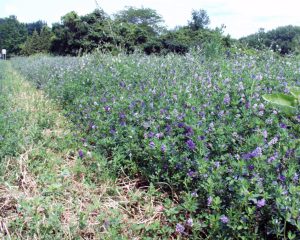
Alfalfa (Photo by Peter Borst)
The Leguminosae (Fabaceae) is the most important plant family for beekeeping in North America and many of its members are calciphiles. Legumes are extremely important to agriculture and are a basic element of crop rotations. Members of the legume family include alfalfa, white clover, sweet clover, alsike clover, vetch, black locust, peanuts, lupine, acacia, mesquite and redbud. The legume family has 18,000 species and is the third largest family in the angiosperms. Alfalfa and the clovers have a very strong affinity for soils with a relatively high pH. This is due to their high demand for nitrogen and these plants can actually be grown on soils with a low pH if supplied with large amounts of nitrogen fertilizer. The legumes are famous for their symbiotic relationship with nitrogen fixing bacteria (a.k.a. rhizobia) located in nodules on their roots. Different species of rhizobia are specific to different legumes (with some exceptions). These bacteria will not grow in acid soils because the micronutrients molybdenum, copper and cobalt are required for enzymes used in the nitrogen fixation process. The nitrogen fixing bacteria are even more sensitive to a low pH than the legumes that it supplies with nitrogen.
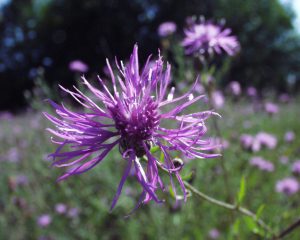
Spotted Knapweed (Photo by Peter Borst)
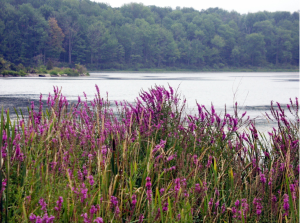
Purple Loosestrife (Photo by Peter Borst)
Some examples of plants that prefer high lime soils but will grow in other soils include spotted knapweed and purple loosestrife. Both of these plants have been spreading throughout New York State, where I live. In areas with high pH soils, these two plants (along with white clover and basswood) contribute to a sustained honey flow that begins in early July and continues through the end of August. Though knapweed and loosestrife are now common in areas with acid soils south of here; beekeepers there still report a dearth from mid-July until goldenrod starts blooming in the middle of August. So these two plants grow on these acid soils but do not produce much nectar there.
The greatest examples of calciphobes are plants that belong to the Ericaceae, another very important family of honey plants. Included are blueberry, cranberry, Manzanita and madrone in North America. Common heather or ling in Great Britain is also in the Ericaceae. All grow in strongly acid soils. For example, blueberry prefers a range of 4.2 to 4.8 pH. These plants rely on their association with mycorrhizae to obtain nutrients that are not readily available in acid soils. Mycorrhizae are ground fungus that are symbiotic with the roots of most plants. Their mycelium reach further than the root hairs of plants and being a fungus, they break down the organic matter present in soil. While the mycorrhizae supplies nutrients, the plant repays with sugars and carbohydrates.
Mycorrhizae translates to fungus root and refers to the association between plant roots and soil fungus.
More than 90% of plant species studied have a symbiotic relationship with mycorrhizal fungi. There are many species of mycorrhizal fungi. Some are associated with only one plant species, while others will work with many species of plants. Some plant species will not survive without mycorrhizae, while others benefit but can live without it.
Soil scientists in the United States realized the importance of mycorrhizae when tree plantings failed in the Midwest during the 1930’s. These plantings were meant to reduce wind erosion during the dust bowl era. These plantings were made in soil devoid of the proper mycorrhizae.
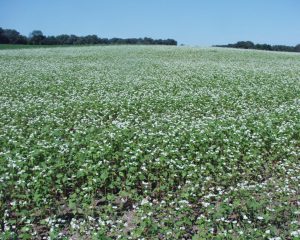
Buckwheat (Photo by Peter Borst)
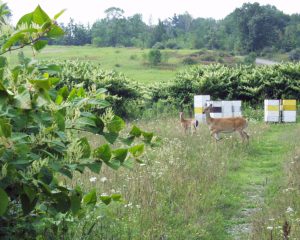
Japanese Knotweed (Photo by Peter Borst)
Famous calciphobes that prefer moderately acid soils but will grow on higher pH soils include goldenrod (Composite family) and buckwheat (Polygonaceae) and japanese knotweed (Polygonaceae). It is common enough to see goldenrod on high lime soils. It does yield some nectar and there is the associated odor from hives making goldenrod honey. Because of its low yield, a saying among beekeepers with hives on high lime soils is “you can smell goldenrod honey but you can’t see it”. In a similar manner, buckwheat will yield some nectar on high lime soils but prefers moderately acid soil. A few years ago, I had bees placed near hundreds of acres of buckwheat growing on high lime soils; unfortunately the bees only brought in enough buckwheat to slightly darken my nice light honey.
While it is a useful generalization to classify honey plants as calciphiles or calciphobes, the plant world is not just black or white. There is a continuum of plants with preferences to pH. While there is variation in pH’s of soil across the landscape, there are plants that have developed that are adapted to those environments. The accompanying table from Purdue University (right) shows how different crop species are adapted to a wide range of pH. It is interesting to note that there is some overlap between the optimum pH for buckwheat and many of the legumes so there will be some locations where both will yield honey crops.
While much of this article has focused on soil pH, there are many other soil factors (edaphic factors) affecting plant growth. Among these factors are texture (the proportion of sand, silt and clay), soil profile and depth, parent material, organic matter and soil organisms, structure, porosity, moisture, soil air, topographic location and soil fertility (either natural or from the fertilizer bin). Environmental factors such as extreme temperatures, humidity, aspect, wind, day length and fire may affect plant growth and honey production more than soils. Biotic factors such as plant competition, disease and herbivores can also affect plant growth more than other factors.
Some honey plant species have an optimum pH for growth and nectar production in the range of 6.5 to 7.0 but still there are significant honey plants in areas outside of this pH range. Growth and honey production are limited more by some of the aforementioned soil, environmental and biotic factors. Some examples are thyme, basswood, black locust, tulip poplar and sugar maple.
Wild thyme, a member of the mint family (Lamiaceae), is an introduced plant in New York and is well known as a honey producer on high lime soils south of Albany as well as lower pH soils in the Catskills. Thyme prefers well drained soils, is drought tolerant and does best in full sun. Another famous mint is sage, also known as salvia. There are as many as 18 species of sage in California, the most notable being black sage. Sage can be found growing in soils with pH ranging from 4.0 to 8.0. It is very drought tolerant and prefers well drained soil. It will not persist in soils that are continually wet.
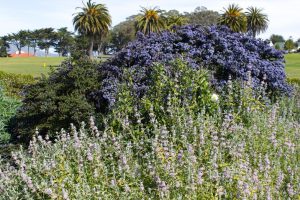
Black Sage with California Lilac in background (Photo by Peter Borst)
California Lilac (Ceanothus spp.) grows on acid or alkaline soil, thrives in full sun and well drained soil but benefits from moderate to heavy rainfall. There are many varieties (or species depending upon whether you are a splitter or clumper) of this plant in coastal mountains of California. Some varieties produce surplus honey while others are worked more by bumblebees. The Ceanothus is one of six genera of the 55 genera in the Rhamnaceae (Buckthorn) family that have nitrogen fixing bacteria on root nodules similar to legumes (Fabaceae).
Black locust is a member of the legume family. Before the primeval forest was cleared by European settlers, the original range of Black Locust was restricted to areas with high pH soils in the central Appalachians. Since that time black locust has been widely planted because of its resistance to fungal rot and its use as fence post material. Fortunately for beekeepers, this legume yields nectar everywhere it is grown. We can infer, though, that it probably yields nectar better in high lime soils similar to its natural habitat.
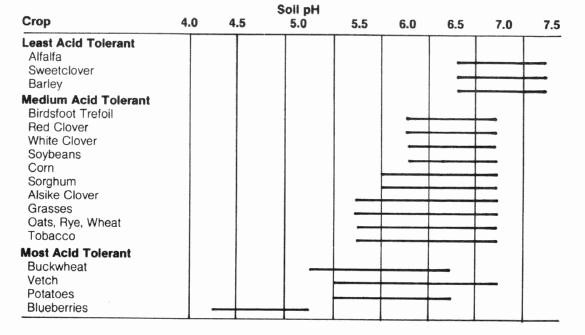
Range of pH Tolerances for Different Crops (Purdue Forage Information)
Tulip poplar, a member of the Magnolia family, will grow on soils with pH ranging from 4.5 to 7.5. It does prefer deep soils that are moderately moist but also well drained.
Sugar maple is a good honey and pollen plant in very early Spring. The pH range for growth is 3.7 to 7.9 but does best in the range of 5.5 to 7.3 pH. According to a U.S. Forest Service fact sheet, it will typically comprise 52% of a mature stand of trees in New York but only 17% of a mature stand in Minnesota and Wisconsin.
It will grow in a wide variety of soils and its range extends from northern Canada to the Gulf Coast. It can tolerate a minimum temperature of negative 46 degrees Fahrenheit. It is not a wetland plant. The greatest limit to its range is droughtiness. It is a shade tolerant tree but will be out-competed by more rapidly growing species such as white ash or black cherry in full sun.
Basswood will grow on soils ranging in pH from 4.5 to 7.5. It reportedly does best when the pH is in the 6.5 to 7.0 range, but large honey crops have been obtained from basswood in areas with acid soils. The range of this plant is very similar to the range of sugar maple and is closely associated with it. It is not quite as shade tolerant as sugar maple. It is a nitrogen demanding species. It is limited by droughtiness and grows better with a north facing or east facing aspect.
So how are some honey plants affected if we just consider soil texture? The optimum soil texture for agricultural crops is referred to as a loam. This is a mixture of the three soil size particles: sand, silt and clay. While sand is helpful in providing drainage, it is not a good source of nutrients. Clay particles are a good source of nutrients but a heavy clay soil is a difficult medium for the growth of plant roots. Silt is intermediate in qualities between sand and clay. Our most important honey plants in the legume family are adapted to a wide range of soil textures. While the optimum texture for alfalfa and sweet clover is a loam, they will also grow and yield honey on all soil textures. White clover will do well on clay or loam soils. Asters (composite family) will do well on soils ranging from sand to clay. Goldenrod (composite family) does well on clay soils. So, soil texture in many cases will not determine what plants will grow on a site. Optimum soil texture will promote optimum growth and vigor of plants.
Admittedly, this article is only scratching the surface of the relation between soils and honey production. There are many more honey plants and environments to consider beyond the scope of this article. For each habitat with different qualities, there have been plants that have adapted to grow there. It is up to the beekeeper to learn the qualities of the habitat where their bees are placed and what plants grow in that particular area. A good start to learning about your situation would be obtaining a copy of Honey Plants of North America by John Lovell (it can be found at Bee Culture’s Bookstore: https://store.beeculture.com/1926-honey-plants-of-north-america/). While this article is an introduction to the subject, Mr. Lovell wrote a whole book about it.
In the next article, we will focus on how different soil types influence honey production. The USDA Soil Conservation Service (now Natural Resource Conservation Service) has done a lot of valuable work mapping and explaining the soils of the United States. With this information, it will be apparent why there are great concentrations of commercial beekeepers in certain areas while not so much in others. For the non-migratory beekeeper, a knowledge of soils may be useful in finding better locations not far from home as well.
]]>The Carl Hayden Bee Research Center (CHBRC) in Tucson, Arizona is the nutrition laboratory of the USDA-ARS bee research program. The Laboratory studies nutrition in a broad sense and conducts research on defining colony nutritional needs throughout the year, acquisition of nutrients from pollen, environmental and landscape factors that can influence nutrients in pollen, and worker-worker and worker-queen interactions. The role that microbes play in nutrient metabolism and defense against invading pathogens also is investigated. The impact of nutrition on the population dynamics of colonies is another research area, as colony growth in the Spring affects its size in the Summer and Fall and the chances of surviving the Winter. Recently, we have added the effects of climate change on colony growth and survival as weather conditions can affect the availability of flowering plants, nutrient composition of pollen, overwintering survival and colony growth in the Spring.
Research at the CHBRC is led by five scientists with specialized areas of expertise that create an integrated and comprehensive program focused on honey bee nutrition. The areas are honey bee physiology (Dr. Vanessa Corby-Harris), chemical ecology (Dr. Mark Carroll), population dynamics and behavior (Drs. Gloria DeGrandi-Hoffman and William Meikle) and microbial ecology (Dr. Kirk Anderson). The following is an overview of each program highlighting how they interact to achieve the goal of providing a comprehensive understanding of nutrition that can optimize colony health and reduce colony loss. To obtain more information and read about our latest findings, go to: https://www.ars.usda.gov/pacific-west-area/tucson-az/carl-hayden-bee-research-center/
Dr. Vanessa Corby-Harris (VC-H)
The Corby-Harris laboratory studies honey bee nutrition, with the goal of improving honey bees’ access to high-quality natural forage and supplemental diets. The lab’s first area of focus is to measure how bees use the nutrients in pollen and how the patterns change with seasons. Combined with information about changes in the colony’s adult and brood population size during the annual colony cycle, these studies will determine what nutrients colonies need throughout the year. For example, in periods of population increase in the Spring and Summer, nurse bees have large amounts of protein in tissues important for brood food production (i.e., hypopharyngeal glands and fat body). Therefore, higher protein diets could be more beneficial during times of colony growth. In periods of colony contraction when preparing for Winter, the physiology of nest bees shifts from storing and using protein to make brood food to an overwintering profile favoring lipid storage. The lipids provide concentrated energy to help bees endure periods of confinement in colder conditions. Therefore, colonies preparing for Winter could benefit from diets with less protein but more lipid.
The VC-H lab is also researching how to improve supplemental diets by comparing them to natural pollen, finding what nutrients the diets are missing and asking whether those missing nutrients affect bee health. An initial comparison between pollen and commercial supplements showed that supplemental diets vary in their lipid content and many lack certain lipids that are found in pollen. In a Fall field trial in North Dakota (funded by Project Apis m.), the VC-H lab found that colonies consuming certain supplemental diets stored more lipids going into Winter and grew more in the Spring compared to colonies fed lipid-deficient supplements. The lipids also may play an important role in behavior and colony health. Dr. Meghan Bennett, a postdoctoral researcher in the VC-H lab, found that certain lipids help bees discriminate between damaged and healthy brood. Megan Deeter, a graduate student (research funded by Project Apis m.), found that dietary lipids improve pesticide resilience. These studies can be used to improve existing dietary supplements, particularly for colonies undergoing key seasonal transitions or that are under stressful conditions.
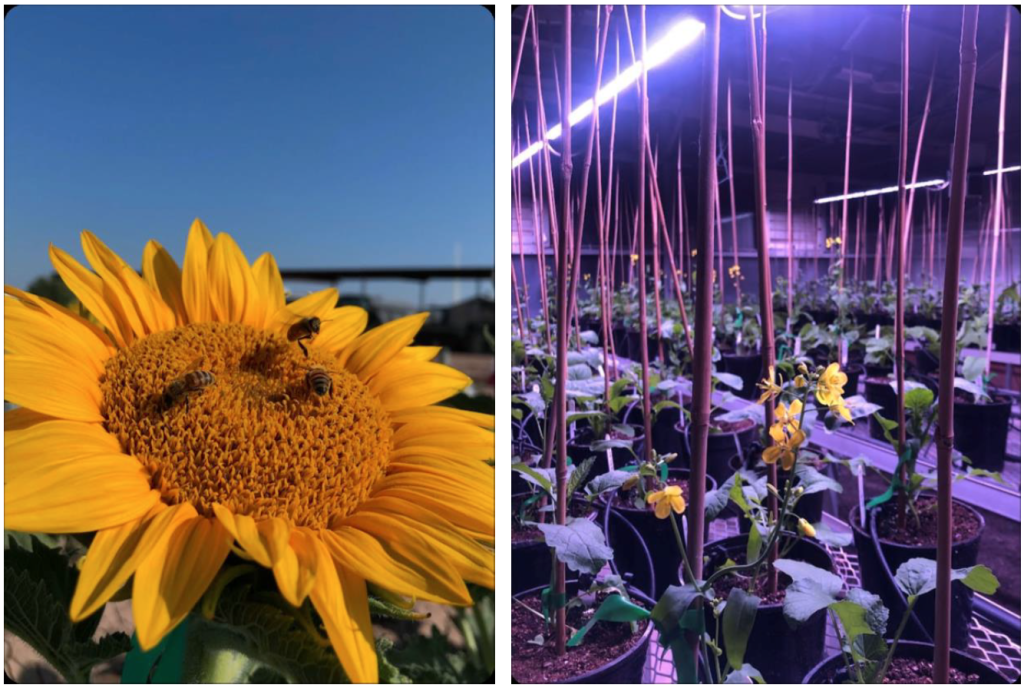
Figure 1. Honey bees visiting sunflowers in the field to test the attractiveness of different cultivars. The nutritional composition of the pollen from the sunflowers also was collected so comparisons could be made among the cultivars. Brassica plants also are grown in greenhouses under controlled conditions to determine the effects of environment on nutrients in pollen.
The last area of research in the VC-H lab focuses on how the environment might affect the nutritional value of bee forage (Figure 1). This area of investigation was prompted by discussions with stakeholders and scientists, and visits to the Northern Great Plains in an atypically dry year. Using sunflowers, an abundant Summer/Fall resource in the Upper Midwest, VC-H and colleagues from the Fargo, North Dakota ARS lab first looked at how pollen nutrients differed for plants grown in either North Dakota or Arizona at the same time of year. Essential nutrients, such as fatty acids differed across locations, suggesting that plant growth conditions affect pollen nutrition. The team is now using field, greenhouse and growth chamber experiments to test this question under more controlled conditions where temperature and soil moisture can be carefully manipulated. This project has multiple implications for honey bee nutrition and colony health. For example, if drought diminishes pollen nutrients, and certain plant cultivars are more resistant to drought, bee health might be improved by growing these cultivars in drought-prone areas. Knowing how environment affects bee nutrition can also translate to better predictions for how colony health will respond to different weather conditions.
Dr. Mark J. Carroll (MJC)
The MJC lab examines how honey bee stressors (poor nutrition, pesticides, parasites and pathogens) affect coordination and performance of critical colony functions such as queen care, brood rearing, nutritional balance and resistance to pathogens and parasites. The MJC lab also has led the efforts to analyze the nutritional composition of pollen by developing nutrient analysis methods for amino and fatty acids. The development of the nutritional analysis methods has enabled our investigations of the nutrient composition of seasonal pollens, and effects of environmental and genetic factors on the nutrients in pollen.
In addition to developing methods for nutritional analyses, MJC also researches semiochemical (pheromones, odors, other chemical cues) communication systems in the hive. As a chemical ecologist, MJC identifies the chemical cues that trigger worker behaviors for important colony tasks including queen care, brood and adult feeding, food stores maintenance and hygienic responses to disease and parasites. However, semiochemical-mediated communication can be disrupted by colony stressors. Our research is directed at understanding how semiochemical communication is affected by stressful conditions, and then use this knowledge to counter stressors through better monitoring, management interventions, and targeted development of hive remedies. The MJC laboratory recently identified odor cues that strongly attract nest workers to starving adults and brood, the first step in feeding support of malnourished individuals. Some of these are colony pheromones that vary considerably with individual and colony nutritional states and affect worker nursing behaviors. MJC is currently examining how workers respond to starvation cues during times of forage dearth and abundance. The odors may provide insights into the colony nutritional state and could serve as tools to determine if supplemental feed and management approaches are reducing malnutrition.
The Carroll lab is exploring how chemical signaling might be used to improve hygienic behavior. Pathogen-infected and parasite-infested bees give off odors that differ from healthy individuals, whether as generalized distress signals, odors from damaged tissues or odors produced by the natural enemies themselves. Workers use chemical cues to detect and hygienically remove stressed individuals from the colony before they become highly infectious to other colony members. MJC is exploring chemical signals associated with early infections that may serve as cues for rapid hygienic responses. To date, MJC has identified odor cues produced by asymptomatic larvae and adult workers during the early stages of infection by the chalkbrood pathogen Ascosphaera apis. Similar cues produced by bees infected by other pathogens and parasites could be used to select for hygienic lines with more timely and targeted responses.
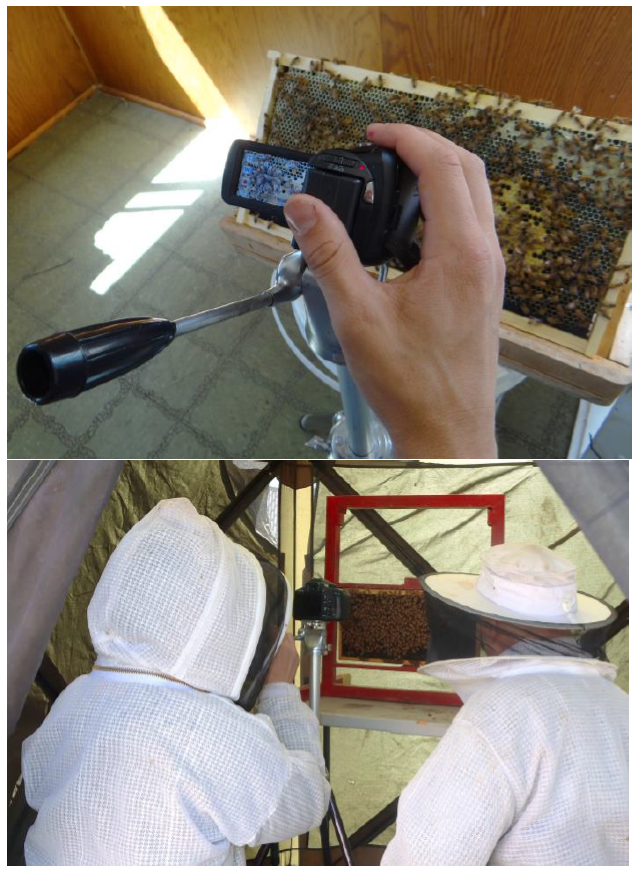
Figure 2. The Carroll lab observes queen retinue behaviors in temperature-controlled conditions. Please note that daylight has been added to see activities here. These videos are usually taken under red light or in shaded tents.
A central focus of the Carroll Lab has been on improving queen quality and productivity. Queens are largely shielded from direct impacts of colony stressors such as poor nutrition and pesticide exposure by the workers that tend them. However, stress can affect the queen indirectly through the workers that care for her and raise her brood. MJC recently found that worker hypopharyngeal glands and internal nutrient stores (used to make jellies to feed queens and brood) decrease sharply as the colony expands after crop pollination probably due to increasing nutritional stress. Improving worker seasonal nutrition supports both queen productivity and brood rearing as colonies endure nutritional dearths (Figure 2). Exposure to pesticides might also affect queen health. MJC recently found that the Insect Growth Regulator, methoxyfenozide does not affect queen development, most likely due to the absence of the compound in royal jelly but does affect queen mating and sperm storage.
Dr. William Meikle (WM)
The Meikle lab focuses on continuously monitoring the activities of bees within the hive or laboratory cages to determine how factors such as pesticides, cold storage or queen line influence colony weight (i.e., growth, foraging activity and honey stores), internal temperature and CO2 concentration. Once installed, the electronic sensors can detect changes in honey bee behavior and colony population dynamics with little or no colony disturbance and provide objective longitudinal data. Methods have been developed to statistically model daily weight changes. Those changes provide information about colony food stores and dramatic shifts in adult bee population associated with events like swarming, bee kills or robbing. Within-day changes in weight reveal foraging activity, foraging success and the precise activity schedule of the hive.
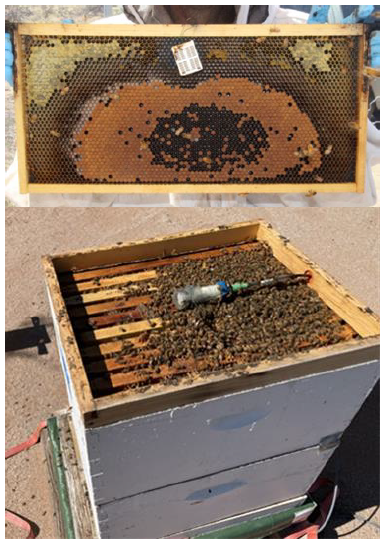
Figure 3. Temperature sensor installed near the top rail of the center frame in a hive. The CO2 sensors are installed in a riser space on top of the frames.
Colony temperature, humidity and CO2 also can be continuously monitored. The values obtained depend on where in the hive the sensors are placed (Figure 3). For example, temperature sensors installed in the brood area to monitor thermoregulation provide different values than sensors placed outside of the cluster near the interior wall of the hive. Average brood nest temperature and variability provide a strong signal regarding colony survival and success. In addition, temperature variability is highly correlated with brood rearing effort and can be used to identify factors that disrupt this activity. Our data on CO2 levels in the hive indicate that concentrations can be much higher (over 100 times) than ambient levels and much more variable. CO2 concentrations above ambient concentrations are generated by the bees, so CO2 concentration data has information on the behavior and health of the colony.
WM’s lab has used continuous monitoring methods to explore the effects of sublethal pesticide exposure on bee colony behavior. For example, experiments conducted over five years with imidacloprid, a neonicotinoid pesticide, showed that thermoregulation, hive CO2 management and daily hive weight change were significantly affected by pesticide exposure and can impact colony growth and activity even at very low concentrations. The research showed that imidacloprid could inhibit certain colony behaviors at high concentrations (100 parts per billion), and agitate the bees at low concentrations (five parts per billion). Thermoregulatory behavior also was monitored using sensors in a temperature-controlled laboratory incubator with cages containing small groups of bees exposed to different levels of pesticides and daily temperature cycles. We found that even among small groups of bees without a queen or brood, the pesticide affected clustering behavior and thermoregulation. Continuous monitoring data also revealed effects on colony-level behaviors after exposure to clothianidin (another neonicotinoid) and methoxyfenozide (an insect growth hormone mimic).
Colony behavior, particularly thermoregulation, also has been monitored in commercial settings. In a recent study, WM’s group monitored the colony size and temperature of hives placed in different kinds of environments, from agricultural areas like California’s Imperial Valley, to unmanaged areas. Pesticide residues also were monitored, and results showed that while pesticide exposure, both in terms of concentration and diversity, varied among the environments, it was not often a major determinant of the health of commercial colonies. The factor most affecting colony health was access to forage. Studies conducted by WM’s group monitored the effects of hive orientation on colony growth and behavior and found that east and south facing hives had significantly more foraging activity than others in the Spring. Screen bottom boards also were found to affect thermoregulation and hive CO2 levels. Colonies increased CO2 concentrations when the hive was better ventilated with a screen bottom board, indicating that maintaining high CO2 concentrations for at least part of the day is important for bee colonies.
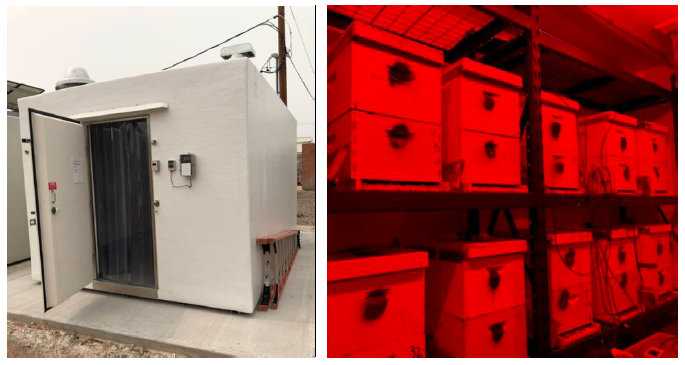
Figure 4. The honey bee cold storage unit (HBCSU), with adjustable ventilation fans, CO2 sensors and temperature control. Hives inside the cold storage unit. The hives were fitted with individual CO2 sensors.
In 2020, the CHBRC installed a cold storage unit (CSU), with temperature and CO2 monitoring and controlled ventilation to explore the effects of cold storage on the health of the colony and on individual bees (purchase of unit partially funded by Project Apis m.) (Figure 4). Currently, the WM lab has been monitoring weight, temperature and CO2 levels in hives stored in the CSU for short periods to induce Fall brood breaks or for longer periods for hive overwintering. The CSU is ideal for the studying of circadian rhythms and the role of CO2 concentration within the hive. In current experiments, hives in the cold storage unit experience constant temperature (about 5°C) and no light, so there are no external cues to “set” any circadian rhythms. Colonies are equipped with temperature and CO2 sensors that generate data that reflect locomotor activity, which is typically used in circadian studies. Within-hive temperature and CO2 control are “emergent” behaviors coming from colonial living, so these studies may reveal new aspects of bee colony behavior and ecology.
Dr. Kirk E. Anderson (KEA)
Studies on the role that microorganisms play in the processing of nectar and pollen in individual bees and the colony are essential to fully understand honey bee nutrition. KEA has characterized many fundamental processes associated with the gut microbiome (i.e., the collection of microorganisms established in the digestive system) and social microbiome (microorganisms transmitted among bees), producing a comprehensive understanding of microbial ecology in the honey bee gut and colony. The specialized bacteria that populate the adult worker hindgut govern or contribute to a variety of physiological processes and behaviors. The bacteria are critical for colony health and have been defined and characterized according to the symbiotic and highly beneficial functional relationships they provide to the bees.
A focal project in the KEA lab is the microbes associated with social nutrient processing. This includes food stores and developing larvae. The adult honey bee gut, larvae and food stores have a highly predictable but very different social microbiome that prospers with exposure to oxygen. This set of oxygen tolerant microbes is found throughout the colony environment. Like aerobic environments in humans (e.g., skin, lungs, mucus membranes), the social microbiome functions in general social hygiene, controlling the growth of Nosema in the midgut, and other pathogenic fungi and opportunistic microbes common throughout the hive environment.
While many microbes are routinely introduced from the pollination environment, the social microbiome is comprised of a suite of beneficial bacteria and yeasts that is part of the microbial collection carried with worker bees when they swarm. Two primary species of bacteria that dominate the social microbiome, Lactobacillus kunkeei and Bombella apis, are core species that also colonize and reside in the queen gut. Newly emerged queen bees do not contact their mother queen, so they might acquire their gut microbiota through contact with the hive and social environment. The microbes carried by a swarm include those that populate the queen gut and the hive environment. When filled with stored food and developing young, the hive environment provides a variety of niche characteristics similar to those encountered in the hindgut environment. KEA has recently shown that the social microbiome is enhanced with exposure to propolis (plant resin) nearly tripling in size relative to low propolis colonies. Additionally, colonies lined with propolis resulted in a 10x reduction of fungi in the hindgut, and significantly more robust bacterial microbiomes.
Symbiotic relationships between the insect Order Hymenoptera and fungi are numerous, and the relationship between bacteria and fungi in the gut is an emerging area of study. The worker midgut possesses the largest fungal microbiome and is affected by changes in pH and oxygen. Studies by KEA suggests that the midgut of late Winter bees is vulnerable to invading microbes following an age associated transition in physiology, and if not countered by immune responses, may contribute to an imbalance among beneficial microorganisms (i.e., dysbiosis) and premature senescence of workers and colonies. In a study with colonies overwintered in cold storage, all sampled worker bees effectively transitioned to long-lived Winter bees. In contrast, colonies kept outdoors in mild Winter environments did not develop into long-lived Winter bees and the aging workers suffered dysbiosis that proliferated primarily in the midgut. Fungal load increased significantly in the midgut and hindgut overwinter, concurrent with significant increases of bacterial opportunists in the midgut. The hindgut microbiota remained relatively unchanged indicating that the midgut is a target tissue for host health in aging foragers and overwintering workers.
In addition to studying the microbes in the worker honey bee gut, KEA has also examined the microbiome of queens. Early queen death or rejection by the colony has become more common in beekeeping. KEA placed newly mated commercially produced queens in either small containment cages (i.e., queen bank) or free-running and laying eggs in colonies. Feeding intensity, social context, and metabolic demand differ greatly between the two environments. A microbiome analysis examining the queen’s mouthparts, midguts, ileums and rectums, and associated gene expression analysis of other tissues found that both social context and queen breeder source affect gut microbiota and associated queen metabolism. For example, free-running queens exposed to the colony environment contained significantly less bacterial diversity than the banked queens indicating that social immune factors may shape the queen’s microbiome. Queens housed in queen banks resembled much older queens with decreased beneficial bacteria in the hindgut, and significantly larger ileum microbiotas, dominated by blooms of worker associated gut bacteria. Combined with earlier findings, it is evident that the queen gut microbiota experiences an extended period of microbial succession associated with queen breeder source, post-mating development and colony assimilation. The results suggest that queens may produce signals based on the microbiome that are perceived by workers. In collaboration with commercial beekeepers, we are testing these hypotheses in the coming year.

Figure 5. Feeding supplements to commercial colonies to test for effects on gut microbiota and colony health.
Microbes that do not originate from the honey bee gut or hive environment stand little chance of establishing and surviving in a honey bee colony. KEA performed a longitudinal study of commercial honey bee colonies to explore the effects of probiotics both over the long term, and following antibiotic treatment. The two tested probiotics were comprised of various lactic acid bacteria and yeast commonly fed to humans or used in large animal agriculture. The probiotics had no effect on colony growth, colony weight, the gut microbiome or disease status following seven months of probiotic treatment applied as suggested, or when applied to aid recovery from antibiotic induced dysbiosis. The study concludes that non-native probiotics cannot survive in the honey-rich hive environment or highly competitive worker gut environment (Figure 5).
Dr. Gloria DeGrandi-Hoffman (GD-H)
GD-H’s research program investigates colony population dynamics and the effects of Varroa, nutrition, and most recently climate change on colony growth and survival. The studies on climate change and Varroa led to research to develop best management strategies for overwintering colonies in cold storage. GD-H has studied the population dynamics of honey bee colonies and built computer models to predict factors that influence the growth and survival of colonies throughout the year. Her studies on honey bee nutrition are predicated on colonies having a yearly life cycle, that might cause nutritional requirements to differ between times of brood rearing and colony expansion in the Spring and population contraction and preparation for overwintering in the Fall. Collaborating with Mark Carroll and Vanessa Corby-Harris, polyfloral mixes of Spring and Fall pollens were analyzed to determine if the nutrient composition differed with season. Next, seasonal pollens were fed to bees reared in Spring and Fall, and comparisons were made of the effects on brood food gland development (i.e., hypopharyngeal glands – HPG), and the expression of genes in the fat body between bees fed pollen from the same (in-season) or different season (out-of-season) from when they were reared. Because pathogen challenges often heighten the effects of nutritional stress, GD-H infected a subset of bees with Nosema to determine if bees responded differently to the infection depending on the seasonal pollen they consumed. She found that Spring and Fall pollens were similar in total protein and lipid concentrations, but Spring pollens had higher concentrations of certain amino and fatty acids that support hypopharyngeal gland (HPG) growth and brood production. Bees responded differently when fed in vs. out of season pollen. The HPG of both uninfected and Nosema-infected Spring bees were larger when they were fed Spring (in-season) compared to Fall pollen. Pollen type also affected gene expression and physiology in Spring bees. Fall bee responses to pollen type and Nosema infection differed from Spring bees. In Fall bees, HPG size was not affected by pollen type, though HPG were smaller in bees infected with Nosema. The study showed that physiological responses to seasonal pollens differ between bees reared in the Spring and Fall with Spring bees being significantly more sensitive to pollen type especially when infected with Nosema. The study provided evidence that seasonal pollens may provide levels of nutrients that align with the activities of honey bees during their yearly colony cycle. The findings are important for the planning and establishment of forage plantings to sustain honey bees, and in the development of seasonal nutritional supplements fed to colonies when pollen is unavailable.
A major factor influencing colony survival is Varroa mites. Using Varroa and colony population dynamics models she created with Robert Curry, GD-H found that the growth of Varroa population in colonies far exceeds what is predicted by Varroa reproduction alone. This led to research on the migration of Varroa into colonies on foragers as a possible explanation for the rapid mite population growth in colonies, especially in the Fall. She found that the frequency of capturing foragers with mites at colony entrances was correlated with Varroa population growth. This occurred with mite resistant Russian bees and unselected lines of bees. Research in collaboration with Dr. Judy Chen from the ARS Beltsville Bee Lab showed that Deformed Wing Virus (DWV) levels increased throughout the Summer and Fall and were correlated with the increasing Varroa infestation levels. She tested if supplemental feeding could reduce DWV levels but found that both Varroa and DWV levels were similar between colonies with and without supplemental pollen feeding.
Reducing overwinter colony losses using cold storage has been the most recent area of study for the GD-H lab. This area of research was pursued because climate change is affecting many aspects of beekeeping and colony survival including overwintering survival. Warm temperatures in Fall and even during periods in the Winter in temperate areas cause honey bees to fly when they should be clustered in the hive. Warmer Fall temperatures can lead to extended periods of foraging late in the season resulting in greater proportions of physiologically older bees in the Winter cluster and a deeper population decline during Spring dwindling. Placing hives in cold storage would curtail Fall foraging and possibly preserve the longevity of Winter bees. Cold storage could also reduce Fall miticide applications needed to suppress Varroa population growth from mite migration.
Our research on cold storage began with an analysis of costs for overwintering colonies followed by studies to determine which colonies should be put into overwintering facilities. The cost analysis revealed that putting colonies in cold storage costs less per colony than overwintering them outdoors in southern locations. However, the study also revealed that not all colonies are suitable for overwintering in cold storage. Colonies do not increase in population in cold storage. In fact, colonies lose three to five frames of bees on average. Also, colonies with Varroa do not do well in cold storage. Our study showed that colonies to be managed for cold storage overwintering should be selected in September based on their size and mite loads. To assist beekeepers in choosing colonies to put into cold storage, we developed a decision support tool (https://www.ars.usda.gov/pacific-west-area/tucson-az/carl-hayden-bee-research-center/research/cold-storage/cold-storage-overwintering-tool/) that predicts the probability of a colony achieving a particular size after cold storage based on its size and mite numbers (mites per 100 bees) in September.
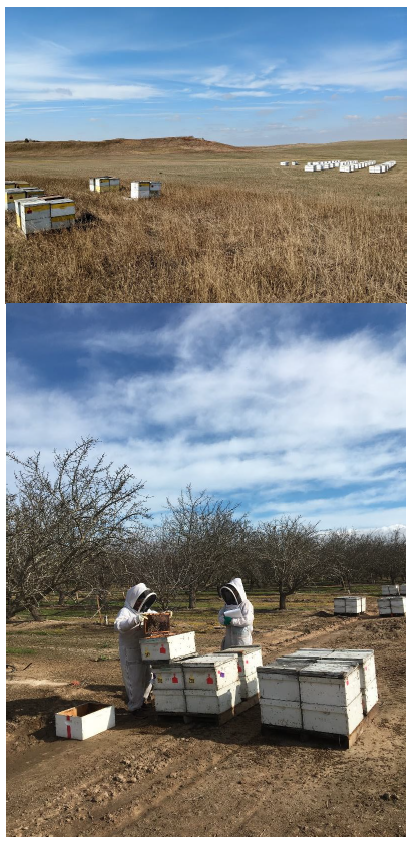
Figure 6. Colonies in North Dakota that were put in cold storage for overwintering. The colonies measured for strength in almond orchards after overwintering in cold storage.
The next questions addressed by GD-H research is when to put colonies in cold storage. Through a study of colonies that spent the Summer in North Dakota, we found that putting colonies in cold storage when they contain only sealed brood and adult bees results in colonies with larger populations and more brood immediately after cold storage compared with those put in cold storage later when they contain only adult bees (Figure 6, next page). The colonies put into cold storage that contained bees and sealed brood also were larger after almond pollination. We also tested if colonies from southern regions that are still rearing brood can be successfully overwintered in cold storage. We found that colonies that spent the Summer in Texas apiaries and then were put into cold storage in November were significantly smaller after cold storage and after almond pollination than those that summered in North Dakota. Our current research is investigating the role that queen line might play in successful cold storage overwintering and is being done in collaboration with Drs. Lanie Bilodeau and Kate Iles at the ARS Baton Rouge Bee Lab. Stay tuned for results.
Grand Challenge Synergies Project
The CHBRC is leading a Grand Challenge Synergies project to create pollinator landscapes and overwintering practices to increase pollinator populations in a changing climate. Grand Challenge projects are designed to address high-order problems of national importance by integrating multiple existing projects across National Programs, Agencies, Universities and the private sector and building collaborations to create something more than the sum of their parts. Our project includes 10 CRIS projects, four National programs, three USDA agencies, four Universities and four private businesses.
Climate change is impacting the survival and diversity of pollinators in two fundamental areas: availability of flowering plants that supply food to pollinators during periods of nest establishment, expansion and reproduction, and survival during overwintering. Our project addresses both challenges by creating a coordinated interdisciplinary effort that incorporates the interactions of genetics (both pollinators and plants), environment, management practices and end users that will play critical roles in developing and implementing the innovative strategies generated from our Project. Specifically, we will assess the composition and nutritional value of landscapes planted to sustain pollinators, determine the effects of genetic, environmental and management factors on the nutrient composition of floral rewards such as pollen, and determine the impact on pollinator diversity and health. We will link nutrition, genetic and environmental factors with management practices to address the second fundamental area being affected by climate change; overwintering survival. By including studies to improve floral landscapes for nest establishment and expansion and management practices to increase overwintering survival, we present a comprehensive year-round plan to sustain and grow pollinator populations. Our findings will be shared with stakeholders involved in production of crops requiring bee pollination, land managers, beekeepers and companies and organizations providing seeds for pollinator plantings so that strategies to ensure pollinator diversity and population growth will be feasible and sustainable in a changing climate.
]]>Click Here if you listened. We’re trying to gauge interest so only one question is required; however, there is a spot for feedback!
Read along below!
Found in Translation
Bees have an increasing say in soybeans
By: Jay Evans, USDA Beltsville Bee Lab
Farmers and scientists debate the extent to which one of our country’s favored crops, the soybean, benefits from honey bee visits. Nor are they sure that having bees visit soybean crops is a net positive for the bees. Despite research documenting strong benefits to soybeans from honey bee visits (dating since the youth of former Bee Culture editor Kim Flottum, https://www.beeculture.com/found-in-translation-19/), a perusal of thousands of studies related to soybean farming shows little emphasis on how and when bees should be deployed. As one metric, a March 2023, Google Scholar search of papers mentioning “soybean yield” and “honey bee” provided 276 references. The same search excluding the term “honey bee” provided 62,200 references. This overall trend has not improved in recent years; papers mentioning soybean yields that do not mention honey bees number 5,110 since 2022, while only 32 papers mention honey bees. Fortunately, those 32 papers provide some really important advances. The upshot is that bees can greatly improve soy production, while potentially gathering a resource for themselves and their keepers. What remains to work out:
- How can beekeepers practice safe soy?
- How can growers choose varieties and management practices that harness bee visits to boost production of a vital row crop?
- How can the two sides meet up to work out deals that benefit both industries and the environment?
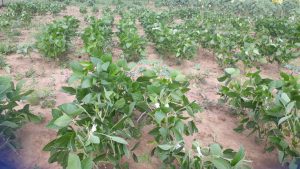 On the soy side, honey bee pollination impacts were described this month in a freely available paper from Decio Gazzoni and João Paz Barateiro (Gazzoni, D.L. & João Vitor Ganem Rillo Paz Barateiro. 2023. Soybean yield is increased through complementary pollination by honey bees, Journal of Apicultural Research, DOI:
On the soy side, honey bee pollination impacts were described this month in a freely available paper from Decio Gazzoni and João Paz Barateiro (Gazzoni, D.L. & João Vitor Ganem Rillo Paz Barateiro. 2023. Soybean yield is increased through complementary pollination by honey bees, Journal of Apicultural Research, DOI:
10.1080/00218839.2022.2161219). These authors showed that, with the right conditions and soybean varieties, honey bees increased soybean yields in controlled environments by 8.5-18.2% in four trials across three years. This increase is not as dramatic as other studies from different cultivars, but still reflects a lot of beans. Hannah Levenson and colleagues at North Carolina State University also showed recently that supporting bees merely by expanding local non-crop habitat led to a significant difference in soybean seed (bean) weights. In an exhaustive survey of 7,000 bees in the field, they found that 30+ bee species had collected soybean pollen but honey bees tended to be more faithful than others for soy versus alternatives (Levenson, H. K., A. E. Sharp, and D. R. Tarpy. 2022. Evaluating the impact of increased pollinator habitat on bee visitation and yield metrics in soybean crops. Agriculture, Ecosystems & Environment 331:107901, https://www.sciencedirect.com/science/article/abs/pii/S0167880922000500).
If bees are generally good for soybeans, are these visits doing bees any good? Chia-Hua Lin and colleagues at The Ohio State University have been on that story for some time and recently published a complex study asking whether bees 1) make it to abundant local soybean fields and 2) bring home resources for their colonies (Lin, C.-H., Suresh, S., Matcham, E., Monagan, P., Curtis, H., Richardson, R. T., & Johnson, R. M. 2022. Soybean is a Common Nectar Source for Honey Bees (Hymenoptera: Apidae) in a Midwestern Agricultural Landscape. Journal of Economic Entomology, 115(6), 1846-1851. doi:10.1093/jee/toac140). In a citizen-science twist, the scientists asked members of the Ohio State Beekeepers Association to bring honey collected by bee colonies from across the state to their Fall meeting. This honey was screened for the presence of different pollen types under microscopy. As indicated by the title, soybean pollen was commonly found in Ohio honeys. More than half of the screened honeys held soybean pollen, and this increased for honey derived from foraging in July and August, when soybean flowers were most common. Finally, the authors used the waggle dance, the signal bees use within their colonies to direct nestmates to good foods, to show that returning bees are eager to tell their nestmates about soybean rewards. For medium-distance flights, returning bees were more likely to ‘dance’ that they had visited soybean fields than other fields, complementing the pollen collection data and saying that bees preferentially target soybean fields over the alternatives. Dr. Lin has backed up this work with some truly remarkable studies covering the attractiveness of dozens of soybean cultivars to bees in common gardens (e.g., https://ohiocroptest.cfaes.osu.edu/soy2022/2022_OSPT_pollinator_report.pdf) and is working relentlessly to improve cross-pollination between beekeepers and soybean growers.
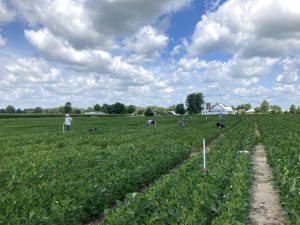
Team B & B (Bees and Beans) collecting flowers in soybean plots last Summer. The white stakes are Karlan Forrester’s audio recorders. Photo provided by Chia-Hua Lin from the Rothenbuhler Honey Bee Lab at The Ohio State University
In ongoing work, graduate student Karlan Forrester (working with Chia-Hua Lin and Reed Johnson at Ohio State), has worked out innovative methods for tracking bees as they zero in on soybean flowers, while also confirming that certain soybean varieties are more rewarding, and hence attractive, to discerning bees (Forrester, K. C., Lin, C.-H., & Johnson, R. M. 2022. Measuring factors affecting honey bee attraction to soybeans using bioacoustics monitoring. BioRxiv, 2022.2011.2004.512777. doi:10.1101/2022.11.04.512777).
In looking for soy-bee stories that describe ways to enhance this partnership, I came across a series of fascinating works from the other side of the world. Dr. Dolapo Bola Adelabu, a researcher from the Free State of South Africa, and his colleague Angelinus Franke, found remarkable increases in soybean yields that can be attributed to visits by bees and other pollinators (Adelabu, D.B., Franke, A.C. 2023. Beneficial Role of Pollination and Soil Fertility for Soybean Production in Mountainous Farming Conditions. In: Membretti, A., Taylor, S.J., Delves, J.L. (eds) Sustainable Futures in Southern Africa’s Mountains. Sustainable Development Goals Series. Springer, Cham. https://doi.org/10.1007/978-3-031-15773-8_5). These yields were greater than 50% when combined with optimal fertilizer supplementation of crops (Nitrogen and Phosphorous), with less striking increases under poor soils. Farming in this region of southern Africa, in a rugged corner of the Free State, is distinguished by “smallholder” farms, where farms are interspersed with homes and natural areas. This farming scheme allows for both wild bee habitat (honey bees are not routinely kept in hives here) and presumably a range of alternate food sources for bees when soybeans are not in flower. In conversing with Dr. Adelabu, the studies did not distinguish Apis mellifera from other bee species, but it seems likely that honey bees were a major member of the pollinating community. Thanks to this research, the services bees provide in terms of local soybean yields, among other crops, justifies the work needed to keep healthy bee habitat. The two scientists in this work are also more broadly interested in schemes to provide healthy nutrition to a fairly dense human population, while maintaining a sustainable environment, ( e.g., https://www.ufs.ac.za/aru/aru-team/aru-team/prof-angelinus-franke). Hannah Levenson phrases it well in her article, “As such, pollinator habitat should be designed to provide resources across the entire active season to help these important pollinator populations, especially since many crops have short bloom durations.”
One hope from all this research for the U.S. will be improved dialogue between beekeepers and soybean farmers, ideally driven by profits on both sides. This dialogue will help bees collect soy flower resources while minimizing collateral damage from agricultural practices, including the need to treat for crop diseases and insect pests. In the meantime, what are the best practices for beekeepers around soybean farms? The Honey Bee Health Coalition has focused on this issue, leading to a draft of guidelines led by Adam Dolezal at the University of Illinois showing how management practices, from pesticide applications to habitat, can be more bee-friendly (https://honeybeehealthcoalition.org/resources/soybean-best-management-practices/). Making more food on fewer acres is good for the planet and the economy, and it is great that scientists and farmers on both sides are tackling the soy-bee system in a rigorous way.
]]>By: James Masucci

A cold, February sunrise in Winnipeg. The backdrop of the annual Manitoba Beekeeper’s Association conference.
Why would any sane person leave their home on a rare, 70 degree February morning and travel to Winnipeg where the highs are zero degrees Fahrenheit? Yes, beekeepers are crazy, but I had a good reason. I was invited to present some mite control data to the Manitoba Beekeeper’s Association at their annual conference. I had done this before, about five years ago, and this remains one of my favorite beekeeping meetings. The two-day meeting is a relatively small gathering of commercial beekeepers, the provincial Apiarist, provincial Ag officials, members of the Canadian Honey Council and honey bee researchers. All the necessary people to dig into the state of the industry.
The agenda of the meeting was driven by the horrible mortality rates that Canada, in general, and Manitoba, in particular, experienced over the 2021-2022 Winter. Mortality rates for the whole of Canada were around 47% and in Manitoba were over 60%. This is for a province that averaged 20% or less mortality for the last eight years or so. Discussions with beekeepers and the report from Derek Micholson, the provincial apiarist, indicate that these losses were caused by the “usual” suspects. A drought in 2021 impacted nutrition, mites and nosema brought disease and weather extended the Winter up to two months beyond their normal extended cold. It’s one thing getting your bees through six months of Winter, but try extending that to eight months. One beekeeper told me how he took his bees out of Winter storage for about a week and had to put them back in due to back to back weather fronts that came. In general, the talks/discussion can be classified into two topics: how to get better queens and how to reduce colony stressors. The latter category was heavily focused on varroa.
Pests, Pathogens and Other Stressors
The tone of the meeting was set with the first talk, Industrial Bees – Is High Density Beekeeping Bad for Bee Health. This was a talk presented by Lewis Bartlett from the University of Georgia and gets to the key question, “are commercial beekeepers shooting themselves in the foot by having large apiaries?” Lewis is akin to a honey bee epidemiologist and his data indicated the answer is “no.” In fact, managed colonies are healthier, in general, than feral colonies. Basically, all bees are exposed to all diseases and there are other factors that influence the severity of the disease that you see. I asked him about the advantages of isolated apiaries and keeping diseases out. His response was that the density of hives is so high, that it’s almost impossible to have a truly isolated yard. It’s okay to place the maximum number of colonies in an area that the forage can support.
Rob Currie, professor at the University of Manitoba, presented one of the few talks on bee stressors that was free of varroa. The presentation, Virus, Pesticide and nutrition interactions in honey bees in Prairie cropping systems: Death by a thousand cuts described the work he and several other researchers did to evaluate different stressors in the cropping systems common to the prairie provinces. The study looked at bees on canola used for oil production, canola used for seed production and soybean, and compared them to colonies in the same region but away from those crops. The data represented the “tool development stage” of a more long-term attempt to understand the interaction between stressors on honey bees. Samples were taken pre-flowering, during flowering and post-flowering. Pesticide prevalence in the hives were higher during flowering and post-flowering in all three cropping systems. This same trend held for sacbrood virus and deformed wing virus in colonies on the edge of soybean fields. Interestingly, sacbrood was high at all timepoints in colonies next to canola fields and deformed wing virus started high in canola and dropped as the season progressed. It will be interesting to see how consistent these findings are and if they are able to find interactions within these cropping systems.
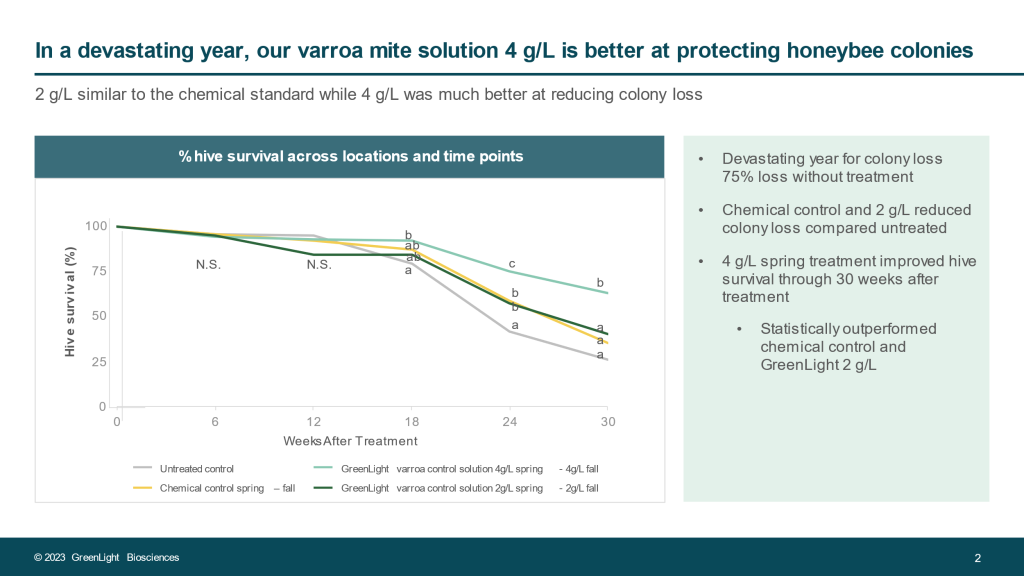
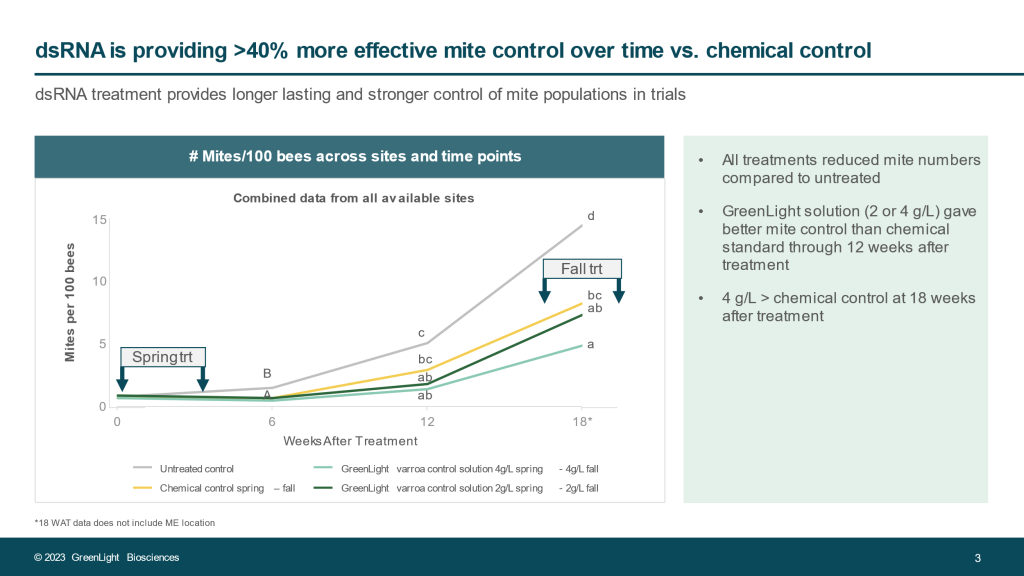
Mite control and preliminary survival data for a novel, RNA-based mite treatment being developed by Greenlight BioSciences. Assessment 1 was at the start of the trial with the chemical control treatment lasting six weeks and the vadescana treatment happening at week zero and week three. Assessments were done six weeks apart. The yellow line represents the untreated control. The red line shows mite data from hives that received a 42-day Apivar treatment at the start of the trial. The light green line shows mite data from hives treated with a high dose of vadescana. The dark green line shows mite data from hives treated the low dose formulation of vadescana.
There were several talks on varroa control. Here I must disclose a potential conflict of interest. I was one of two scientists representing Greenlight BioSciences to discuss the new varroa product they are developing. Greenlight is developing an RNA-based product, vadescana, that directly targets reproducing mites. Brian Manley showed data from several trials indicating that vadescana can keep mite levels below threshold levels for more than 12 weeks. He also showed some preliminary data from an overwintering trial where Vadescana-treated colonies had twice the survival rates as Apivar-treated colonies. The overwintering trial also showed how effective rotating modes of action (i.e. Vadescana in the Spring and Apivar in the Fall) can be for mite control and colony survival. Pending approval from the PMRA, Greenlight will be doing trials in Canada this year.
Steve Pernal, a research scientist with Agriculture and Agri-Food Canada, talked about a new miticide that he is working on. The miticide, 3C(3,6), is a plant based compound that has a similar structure to Thymol. It is not as volatile as thymol and it is not clear how much activity comes from fumigation vs topical exposure. The lack of volatility is an advantage over thymol, in that they have not seen brood kill or queen issues with 3C(3,6). Efficacy ranged from 42% in 2021 to 94% in 2022. The difference reflects product development as they are working out appropriate dosing and application methods.
Amber Leach, of Veto-Pharma, spoke on Apivar. She acknowledged that there seems to be pockets of amitraz (the active ingredient in Apivar strips) resistance and talked about the dangers of off-label amitraz use. Following the Apivar label and rotating different miticide treatments is the best way to combat this resistance. One of the beekeepers pointed out a potential flaw in the design of the Apivar strips. When you use the tabs to keep the strip in place, one side of the strip is pinned against the frame. Thus, you are only treating with half the dose that you should be. It may be more effective to hang the strips using toothpicks, matchsticks, etc. so that both sides of the strip are accessible to the bees.
Breeding for Better Mite / Stress Resistance
Last year in Bee Culture (Bee Driven Mid-Life Crisis Part 2: What’s in a Queen? https://www.beeculture.com/bee-driven-mid-life-crisis-p2/), I talked about the difficulty of queen breeding. Uncontrolled mating and the lack of easy trait selection has resulted in very little improvement in queen quality over the years. There were a couple of presentations that showed we are making baby step improvements in our ability to breed.
Steve Pernal gave a talk entitled Colony phenotypes for breeding and insights into Winter losses. He showed the drivers for colony survival were sealed brood, colony weight and cluster size and showed that hive weight increase from 29kg to 30kg resulted in a 30% increase in probability of colony survival. He also showed that varroa and DWV levels were predictors of mortality. The critical piece to this presentation for me, was that he successfully used marker assisted breeding to increase hygienic behavior in three generations. Marker assisted breeding is where you have a molecular marker, either a protein variant or DNA variant, that is closely associated with a trait of interest. It’s a technique widely used in the rest of agriculture but lacking in honey bees. Steve has a panel of proteins (many are antenna proteins) that are related to hygienic behavior. Steve successfully used these proteins in a breeding strategy to increase hygienic behavior. He compared using no selection, marker assisted breeding and the freezing brood kill assay (liquid nitrogen). After three generations of selection, marker assisted breeding produced the highest level of hygienic behavior, followed by the freeze kill selection. To me, it just emphasizes the need for a good molecular map if we really want to breed honey bees.
In the absence of a molecular map, Kaira Wagoner, of the University of North Carolina – Greensboro, has developed an assay for hygienic behavior that appears to be better than the traditional freeze kill assay. The problem with the liquid nitrogen assay is that it kills the pupae. Therefore, it is selecting for bees to recognize dead pupae. Are the signals produced by dead pupae the same signals that are produced by sick pupae? We want hygienic behavior to target sick pupae. Kaira spent several years identifying 10 chemicals that are elevated in unhealthy bees and developed the correct ratio of these chemicals to mimic what she calls the “unhealthy bee odor” (UBO). She has developed a two-hour assay, where she sprays capped brood with UBO and counts the number of uncapped cells after two hours. She showed that 60% uncapping in this assay was enough to control mite levels. The hygienic bees (those doing the uncapping) had high virus levels, but the hygienic colonies as a whole had lower virus levels than non-hygienic colonies. The system is not perfect. New queens can only be tested after seven weeks past emergence. As with all multigenic traits, maintaining the trait will be difficult. However, the assay is relatively simple, so for people willing to put in the effort, it will be feasible to select for hygienic behavior.
Queen Quality
In the absence of true queen breeding, what can be done to increase queen quality? Medhat Nasr, working for the Saskatchewan Tech Team, assessed queens from several Saskatchewan queen producers and four queen producers from California. This is important to Canadian beekeepers because they import a lot of queens. He looked at queen size (head and thorax), nosema counts and sperm counts. On average, he found three million sperm in the Saskatchewan-made queens and 1.8 million sperm in the imported queens. To put this into perspective as to what this means, he did a back-of-the-envelope calculation. A queen produces 2,000 eggs a day and each egg induces the release of three to four sperm. Therefore, the queen needs about 1.1-1.4 million sperm per year. When the sperm runs out or gets low, you either get a drone layer or supercedure. When he showed the data for individual queens, 20-50% of the imported queens (depending on producer) had less than a million sperm, indicating they could not last a year. I asked him why he thought this was the case and he felt it was due to the mating yards being too dense without sufficient drones.
Provincial Apiarist Report
Manitoba’s beekeeping industry suffered in 2022. Over 60% losses over Winter had several effects. The number of beekeepers declined for the first time in about 15 years (from 925 to 905). The number of colonies dropped from around 115K to 103K. Honey production dropped 15-20%. The saving grace was an increase in honey prices, which greatly buffered the impact of the losses.
Manitoba’s Knowledge and Research Transfer Program (KRTP) did some testing for amitraz resistance. They used both the four hour Apiarium test and the 24 hour Pettis test. They found that amitraz efficacy ranged from 15% to 100%. There is definite evidence for pockets of amitraz resistance.
Derek also reported on the priorities of the National Industry-Government Bee Sustainability Working Group. This is a large group made up of both government and industry representatives. Their top priorities are to support the Tech Transfer Programs. These programs are in every province and they perform locally relevant, applied research as well as extension services. They are also coordinating at the national level to work on common beekeeping issues. Top priorities of the working group also include accelerating the development of new varroa control solutions, actions to maintain and increase domestic bee supplies and actions to address long-term challenges to importing bee supplies. Their secondary priorities are to improve the overwintering of queens (which will ease the need to import queens), business cost analysis of the industry and the opening of the U.S./Canada border to package bees.
Opening Up the Borders
Opening the U.S./Canada border to package bees is a hot topic. I had a few conversations with beekeepers over this. In the U.S., beekeepers in the northern states buy nucs, queens and packages from the southern states. Some beekeepers are concerned where their bees come from. For example, the bee club I belong to only orders queens from Northern California, because of a concern of bringing in Africanized bees. (I, on the other hand, get queens from TX, LA and GA). The same holds true in Canada. They need bees and queens, just like the Northern U.S. states do. But the U.S./Canada border has been closed to bee traffic since tracheal mites in the 1980s. Canada brings in bees from Australia, New Zealand, and now Italy and Ukraine. They do get some queens from HI and CA, because they have established safe zones where there are no Africanized bees within 100 miles. In CA, this safe zone was recently reduced to 50 miles due to the detection of Africanized bees within the 100-mile zone.
So, do we bring in bees from across the ocean and potentially bring in a new pest or pathogen from there? Or do we treat North America as one isolated domain and move bees within that domain knowing there are Africanized bees in the south? The Canadians worry about Africanized bees and about antibiotic resistant AFB in the states. The U.S. is worried about viruses and don’t allow the importation of Canadian queens.
The Canadian Honey Council has provided the CFIA with the data necessary to redo a risk assessment for the importation of packages from the U.S. This issue now rests with the CFIA. Whether they act on this will likely depend on the pressure they get from both Canadian beekeeping organizations and the U.S. I am sure this issue is as much political as it is biological.
What does Canadian beekeeping have to do with me?
Having attended beekeeping meetings in both countries, I realize that beekeeping is a global industry. We are all dealing with the same beekeeping issues. I’ve learned a lot about beekeeping from both Canadian colleagues and U.S. colleagues. I take the best of both worlds and apply them to my own operation. A case in point is Lloyd Harris. I bet most beekeepers in the U.S. have not heard of him. I met him about five years ago and he changed the way I think about bees. He closed out the conference with his presentation The Winter colony and its formation. The talk was based on his graduate work he did back in the 70s. He painted cohorts of newly emerged bees every 12 days throughout the year to determine their longevity. From this data he draws incredible insights into the dynamics of the hive throughout the year. Is this data still applicable and useful? Of course it is! If any of you have heard Randy Oliver or Ian Steppler talk about beekeeping, they both show a graph of the colony age distribution throughout the year. It’s Lloyd’s graph. It doesn’t matter how long ago or where he did the study. We have a lot to learn from each other.
One aspect of the Canadian industry that I really like is how closely tied the Canadian Honey Council is to the beekeeping problems of the industry. They don’t just lobby for funding and legislation but get into the weeds to help solve problems. For example, the CHC owns the registration for formic acid and Fumagillin. Currently, the CHC is working with the Ontario Tech Team to get Oxalic Acid/Glycerin strips registered. By doing this, they ensure the beekeepers get the tools they need. The path to registration is expensive and complicated. Unless you are a company with millions of dollars to invest in the product, you won’t be able to afford the registration process. And the beekeeping industry is too small for it to be an incentive to large companies. Once a company does go through the process, they need to charge a lot to recover the costs. Because the CHC owns formic acid, the beekeepers can mix their own treatments (probably a double-edged sword), and likely, will make their own OA strips as well. I wish our beekeeping organizations took a similar approach.
To go even further, wouldn’t it be nice if there was international cooperation between our beekeeping organizations in this regard? Registration packages are relatively similar in various countries. By sharing resources and costs, a path can open for special cases; emergency needs, individual discoveries, etc. We wouldn’t have to be dependent on Randy Oliver doing all the work himself or we wouldn’t have to worry if Steve Pernal’s product would ever get registered because he doesn’t have the funds. I think there is an opportunity here. We can get a lot more done by working together on common problems.
]]>Click Here if you listened. We’re trying to gauge interest so only one question is required; however, there is a spot for feedback!
Read along below!
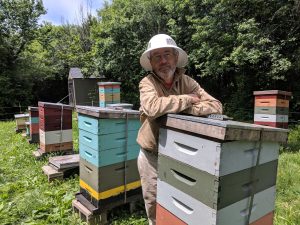
Tropilaelaps
Part 2
By: Ross Conrad
Last month, we looked at the Tropilaelaps mite and its potential impact on North American beekeeping. While Tropilaelaps has yet to appear on the shores of North America, it can be found in the middle of a spat between the American Beekeeping Federation (ABF) and the Canadian Honey Council (CHC) over package imports.
A Warning Issued
On February 1, 2023, the ABF released a statement issuing a call for American beekeepers to encourage their congressional delegations to support the opening up of the Canadian border to honey bee package importation from the United States (Winter & Miller, 2023). The ABF letter notes that “the threat of the T mite (Tropilaelaps) being found in a southern hemisphere package and introduced to Canada is a real threat to all North American beekeepers.” The letter goes on to say, “This would be devastating to the North American beekeeping industry and production agriculture.” Furthermore, “ABF believes a new expedited risk analysis is needed” for both U.S. packages and those from other countries currently approved to export bees to Canada, in order to properly assess the current risk of a possible Tropilaelaps infestation.
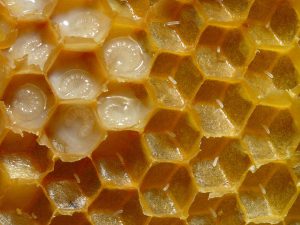
Tropilaelaps’ need to access uncapped brood in order to feed every two days or so is the primary reason why it has not spread around the world so rapidly and extensively as the Varroa mite.
So far, Tropilaelaps has spread among South Asian countries including India, China, Pakistan, Myanmar (Burma), Thailand, Sri Lanka, Philippines, Afghanistan, S. Korea, Vietnam and Papua New Guinea. New Guinea and Australia are about 150 km (93 miles) apart at their closest shores: roughly the distance between Cuba and the U.S. mainland. The Canadian Food Inspection Agency (CFIA) currently allows the importation of honey bee packages into Canada from Australia, New Zealand, Chile, Ukraine and Italy. Queen imports into Canada are allowed from the same five countries as well as from the United States, Denmark and Malta. Given the close proximity of Canada’s Australian source of bees to a known Tropilaelaps infested country (New Guinea), the ABF is sounding the alarm concerning the risk of the mite making its way to Canada and then to the U.S.
Canada Weighs In
On February 22, 2023, the Canadian Honey Council responded to the ABF with their own statement (Scarlett, 2023). In it, the CHC called it “unfortunate that the American Beekeeping Federation, the American Honey Producers Association and those Canadian operators having an interest in importing American packaged bees are attempting to capitalize on the fear of introducing Tropilaelaps mites.”
The CHC goes on to say, “last year, Canadian beekeepers from most areas in the country experienced devastating losses and the demand for stock increased dramatically. Calls to open the border to U.S. packages intensified… The Canadian Food Inspection Agency put out an open call for additional research to see if there were any changes to the risks that had been identified in a 2013 risk assessment of U.S. packages.” The risks identified in 2013 were: Amitraz resistant mites, small hive beetle, American foulbrood resistance to antibiotics and Africanized bees. “The CHC has indicated that if the science supports the decision to open the border, the border should open,” the statement emphasized.
The CHC went on to note that since U.S. beekeepers can import bees from just two countries, Canada and New Zealand, and “New Zealand is just as close or closer to where Tropilaelaps is found…” they suggest that the U.S. could also import bees with the potential to harbor the mite. The CHC statement concludes by stating, “a North American concern is justified but it is far more likely that the mite will arrive by ocean liners than it is by packaged bees. The U.S. has 162 ocean freighters arriving every day and many of those are from China and Japan, two countries much more likely to have unwanted ‘visitors’ aboard. That is why calls in the USA for sentinel hives at ports have increased… This is not a trade issue, and it is always looked at as an animal health risk issue.”
| Year | # of Packages | Year | # of Packages |
|---|---|---|---|
| 2008 | 11,070 | 2016 | 44,997 |
| 2009 | 11,360 | 2017 | 27,387 |
| 2010 | 10,611 | 2018 | 31,638 |
| 2011 | 42,466 | 2019 | 41,339 |
| 2012 | 33,913 | 2020 | 13,746 |
| 2013 | 65,066 | 2021 | 8,661 |
| 2014 | 52,774 | 2022 | 56,737 |
| 2015 | 55,786 | 2023 | TBD |
Reality or Hype?
There is a high demand right now among Canadian beekeepers for packaged bees to replace heavy losses. Meanwhile for the first time in decades, almond production is contracting due to low almond prices and water issues aggravated by prolonged drought, and U.S. beekeepers are looking to replace some of this lost income. Opening up the Canadian border to U.S. package imports could help replace lost almond pollination fees.
American beekeepers certainly do not need another stressor on their bees, should Tropilaelaps make its way to America. However, as I pointed out last month, the T mite’s impact is not likely to be as devastating to the beekeeping industry as Varroa was in its initial years. Unlike the situation when the Varroa mite first arrived in North America, today we have approved mite treatments available for Varroa that are reported to also work on Tropilaelaps. We also know more about the biology of the T mite and its critical vulnerability of having to have constant access to its primary food source (uncapped brood) or they starve to death. These facts make the dire warnings spelled out in the ABF letter appear exaggerated.
Real World Impact
So how likely is a mite infestation into Canada from packages or caged queens really? Since no combs of brood are shipped within packages or queen cages, the chance that T mites will infiltrate North America through a bee shipment is slim. As numerous researchers have all pointed out, any mites that make it into the package or cage when it is initially populated with bees, are likely to be dead within two to three days at the most (Woyke, 1984 & 1987; Koeniger & Muzaffar, 1988; Rinderer et al., 1994). This is primarily why Varroa, which also originated in Asia, has spread to the four corners of the earth while Tropilaelaps is still largely confined to its native range.
There are a couple theoretical possibilities where mites could survive importation in packages and queens. If there are package producers or queen breeders that are super efficient and ship orders out the same day that they are packaged or caged, it is possible that the receiving beekeeper will install their shipment into a hive the same day that it arrives via overnight airfreight. Thus, any mites that happen to be riding along in a package or cage would only be without food for a day or so and could survive the trip. To protect American beekeepers, a simple requirement that bee shipments must be held for a minimum of 48 hours before they are introduced into hives containing uncapped brood, would help ensure no Tropilaelaps mites that hitched a ride along with the bees are able to survive the journey. This would mostly affect queen imports since packages are usually installed into hives with foundation or empty frames of drawn comb, or perhaps combs containing some honey and/or pollen. It is rare that packages get installed into hives in which uncapped brood is already present.
The other possibility is that there are occasional reports in the literature of Tropilaelaps being observed sitting at the base of an adult honey bee’s wings. This is significant since the base of the wings is one of the few locations where the hard exoskeleton of the bee is soft enough for the Tropilaelaps mite to be able to pierce it with their mouth parts and feed on hemolymph (Khongphinitbunjong et al., 2012). Thus, it appears that sometimes a T mite figures out that it can feed on an adult bee.
While it is certainly a possibility that Canada will become a Tropilaelaps host country and spread the mite to America, the availability of approved Varroa mite treatments that are also reported to work on Tropilaelaps means that should such an infestation take place, is unlikely to cause a major catastrophe for American beekeepers.
The Scofflaw Factor
Unfortunately, we beekeepers are notorious scofflaws. This tendency exposed itself clearly after Varroa arrived and many beekeepers turned to off-label (illegal) uses of pesticides to control the mites. Since there are likely to be some beekeepers that cannot be trusted to honor a 48 hour delay before installing bees into hives that contain uncapped brood, Canadian bee breeders that supply the U.S. could also be required to wait 48 hours after packaging or caging bees before shipment. This way if one person in the supply chain “bends the rules” the other acts as a backup to ensure the mites are unlikely to survive. Of course, the extensive border between our two countries would almost guarantee that should Tropilaelaps make its way to Canada and spread throughout the country, at some point natural swarms will carry the mite across the border into the United States. However, unless a Canadian swarm usurps a U.S. colony and replaces the mother queen with their usurping queen (a highly unlikely situation), natural swarms are not expected to cause Tropilaelaps to spread across the border. The extended broodless period when a swarm emerges from a hive and when it begins raise new brood in a new location also prevents swarm castaways on an ocean liner from carrying the mite far.
There is always the possibility however that the mite could be smuggled in illegally. Some people claim that back in the 1980s, Argentina was getting bees from Asia, breeding queens, smuggling them into Florida under the radar and ended up bringing the Varroa mite to the U.S. Folks worry that something similar might happen should Australia end up getting the mite, and export the mite to Canada. Please note, all this is still theoretical. As far as anyone knows, while Varroa has recently arrived in Australia, Tropilaelaps has not yet made its way to the island continent.
You Catch More Bees with Honey Than You do With Vinegar
Rather than point fingers at our Canadian neighbors and make them out to be the “bad guy”, U.S. beekeepers would do better to focus on the positive impacts Canadians can expect should they open up their border to U.S. honey bee packages. The main one that comes to mind is an improved environmental footprint.
The American beekeeping industry is very fossil fuel intensive. Regularly transporting bees throughout the country on 18-wheeled, diesel powered trucks and shipping bees overnight by airfreight creates a lot of green-house gas emissions. Dramatically reducing the distance that packages must travel by air, will greatly help the beekeeping industry start to address the festering issue of heavy fossil-fuel reliance that has mostly been ignored to date. This means doing exactly what the ABF recommends, localizing and regionalizing industry so we no longer are relying on extensively long supply chains. The global COVID pandemic exposed the serious drawback of relying on products and supplies that have to be shipped from overseas and the global climate crisis is exposing another. Relocalizing as much of society as possible will be required if we are to successfully reduce energy use and GHG emissions, prevent global ecological collapse, save our bees and maintain organized human existence. An additional benefit is that reduced shipping distances should result in lower overall costs, allowing U.S. bee producers to compete competitively with bees from down under while allowing Canadian beekeepers to enjoy lower prices.
I get the ABF’s concerns. Declining almond prices and a lack of available water from increasing droughts out west is causing many almond producers to pull their older trees from production. For the first time in well over a decade, almond growers will be requiring fewer hives for pollination, not more. For those beekeepers that fell into the economic trap of relying on almond pollination fees for a large percentage of their annual income, the severe economic hit they are going to receive will be challenging. The greater the share of their annual income from almond pollination, the more difficult it will be for the beekeeper to stay afloat. Opening up a new market in Canada for U.S. packaged bees, while certainly not enough to entirely replace the lost almond pollination income, will help take some of the sting out of the loss. Efforts to use the fear of Tropilaelaps to facilitate such a trade agreement is a weak approach.
Ross Conrad is the author or Natural Beekeeping: Organic approaches to modern apiculture and the Land of Milk and Honey: A history of beekeeping in Vermont. Ross will be teaching a beginner organic beekeeping class the weekend of May 20-21 and an intermediate class June 4th in Vermont. For more information visit: www.dancingbeegardens.com
References:
Khongphinitbunjong, K., de Guzman, L.I., Burgett, M.D., Rinderer, T.E., Chantawannakul, P. (2012) Behavioral responses underpinning resistance and susceptibility of honey bees to Tropilaelaps mercedesae. Apidologie 43: 590–599 https://doi.org/10.1007/s13592-012-0129-x
Koeniger, N., and Muzaffar, N. J. J. O. A. R. (1988) Lifespan of the parasitic honeybee mite, Tropilaelaps clareae, on Apis cerana, dorsata and mellifera. Journal of Apicultural Research 27(4): 207-212.
Rinderer, T.E., Oldroyd, B.P., Lekprayoon, C., Wongsiri, S., Boonthai, C.,Thapa, R. (1994) Extended survival of the parasitic honey bee mite Tropilaelaps clareae on adult workers of Apis mellifera and Apis dorsata, Journal of Apicultural Research, 33(3):171-174, DOI:10.1080/00218839.1994.11100866
Scarlett, Rod (2023) Canadian Honey Council letter, https://honeycouncil.ca/
Winter, Dan & Jay Miller, (2023) American Beekeeping Federation letter, https://www.beeculture.com/abf-statement/
Woyke, J. (1984) Survival and prophylactic control of Tropilaelaps clareae infesting Apis mellifera colonies in Afghanistan, Apidologie, 15(4):421-434
Woyke, J. (1987) Length of Stay of the Parasitic Mite Tropilaelaps Clareae Outside Sealed Honey Bee Brood Cells as a Basis for its Effective Control, Journal of Apicultural Research, 26(2):104-109, DOI:10.1080/00218839.1987.11100745
Click Here if you listened. We’re trying to gauge interest so only one question is required; however, there is a spot for feedback!
Read along below!
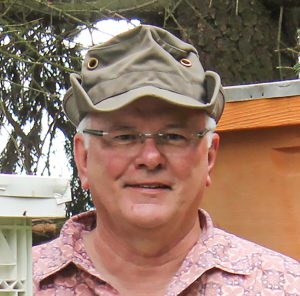 Beeyards Come and Beeyards Go
Beeyards Come and Beeyards Go
An apiary location is just for the moment
By: James E. Tew
An unusual topic
A strange topic this article has – Beeyards that I no longer have. Old, abandoned beeyards have played a major part in my personal beekeeping history and development. They are like long departed friends. Many of you have your old beeyard memories, too. I’m not special in this regard.
As the years have passed, I have steadily cut both the number of hives I manage and the number of yards I keep my bees in. Throughout my career, I estimate that I have had – at one time or another – about 45-60 permanent bee locations. At my peak, I (with help) maintained about sixteen different locations. Now, I have reduced my yards to only two apiaries, both reasonably near me. Yep, that’s quite a change for me.
My emotional attachment to some of these phased-out yards has surprised me. They have names that are totally meaningless to you, but they have been part of my life for years; the Metz yard, the Shreve yard, the Chipley yard, the County Home yard, Matt’s yard and the Fredericksburg yard are some of the many names of places that have now reverted to non-bee areas.
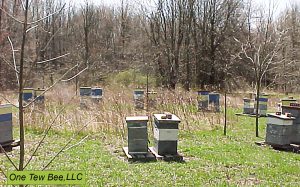
Figure 1. The Metz yard, twenty-five years ago
Specifically, the Metz yard and the Fredericksburg yard were locations that I personally established as a brand-new entomology professor at OSU in 1978. It seems impossible that I had some of these locations for 40+ consecutive years only to close them out. As a young man, I guess I just assumed that these yards would somehow continue forever.
In the case of the Metz yard, it was located off Metz Road, right here in Wooster, Ohio. At that location, through the years, I survived stuck trucks, swarms, American foulbrood, tall grass, the introduction of mites and ground hogs, but on the positive side we made a lot of honey there. Being located near a stand of pines, I, and my help, would gather bags of pine needles for our smoker fuel needs. At the time, it was a major part of my beekeeping psyche.
We were there so long that many years ago, the Senior Mr. Metz died requiring us to get permission from Mr. Metz’s surviving son to continue the use of the yard. He allowed us to stay so I passed into my second generation at this location. Then after decades of use, I finally gave it up, too.
Where is this reminiscing going?
Eliminating these yards made me realize that I have evacuated far, far more yards than I will ever again maintain. Yet each of those now abandoned locations was, for a while, a part of my beekeeping life. Stories and bee events came and went. Now nothing of a bee nature remains at these locations. In fact, there are only a very few people who could even remember the hives were ever there. That’s okay. It’s only important to me anyway.
Memories of some of my long-gone yards
Not all the memories that follow are specifically my yards, but they all contribute to my beekeeping memories. Here are some examples.
The Unit-Two Yard
The reason for the clumsy yard name is unimportant, but the now long-beeless yard has several significant memories for me. It was in this yard that I had the very personal experience of having a mouse run up inside my pant leg as I was removing supers from a hive. I have relived the story literally hundreds of times at meetings across the country, and I choose not to relive it again here, but you can believe that I will NEVER forget the experience I had in that yard (and neither will the mouse).
Reason for giving up the Unit-Two yard. Pesticides. The yard was located near university field plots and every year, the hives located there were seriously damaged by pesticide kills. I now wonder, in light of decreased pesticide use, if that yard could be reoccupied.
The Eck Yard
Mr. Clarence Eck was the grand old beekeeper in Wooster for many years. He was keeping bees long before I moved here. Mr. Eck is no longer with us, but he and others, including Jim Thompson, a frequent contributor to Bee Culture and longtime beekeeping friend, initiated a small beekeeping workshop for helping new beekeepers. This past March, the 44th annual version of this workshop, with hundreds of people in attendance, was conducted. Mr. Eck’s home beeyard, and one in which he conducted early beekeeping classes, was north of Wooster. That yard, too, is now gone.
Reasons for Mr. Eck giving up this apiary site. Concerns from the local Ford Motor Company dealership was the reason for abandoning the yard. The newly located dealership could not figure out where all the “birds” were coming from that defecated on their fine, new cars. It took them a while to figure out that it was neighboring bees – not birds – causing the issue, but when they did discover that it was bee poop on all their cars, under threat of lawsuit, a historical bee location was forced into oblivion.
The Sawmill Yard
In fact, the sawmill and the beeyard are now both gone. About thirty-eight years ago, I wrote a series of articles for the old Gleanings in Bee Culture under the mast head, The Solitary Beekeeper, from experiences I had in this yard. It was from this apiary, that I took a good friend to the hospital emergency room after he had a systemic reaction to multiple bee stings. His tongue was swollen and had become bluish. He recovered in good order, but he won’t ever forget this bee place. Neither will I.
This yard was located on the property of a large, creepy, abandoned state mental hospital. While moving beehives past midnight one dark, quiet night, I inexplicably became spooked – one of those sixth sense things. I couldn’t talk myself out of the threatening feeling. I unhooked the bee trailer from the truck and left some of the hives open and in disarray. When I returned the next day – nothing. No Big Foot – no monsters – no nothing. I recently did a podcast describing this recollection. Now, nothing remains there but memories.
Reasons for giving up the Sawmill Yard. American foulbrood outbreaks and agricultural encroachment. The yard is now a soybean field and the sawmill building is standing derelict.
The Chipley Yard
During the early ‘80s, I kept a yard of about 80 hives of Ohio State (OSU) hives in Chipley, Florida. At the time, I had a thriving international beekeeping program made up of people who wanted to learn more about migratory beekeeping. I wintered OSU bees in Florida and produced Springtime queens there.
I have many, many memories of driving trucks to Florida, loaded with palletized beehives, dead tired, stressed, but being a real migratory beekeeper. It was a spectacular amount of work. No one got hurt. We kept good bees and we all had a good experience. To this day, this yard makes up the bulk of my migratory beekeeping experience. I have a life-long collection of memories of “stuck trucks and late nights” from this yard. As usual, I wrote about my experiences.
Reasons for giving up the Chipley Yard. Bee program redirection, transportation costs and mud (accessibility). I understand that watermelons are now planted where our beeyard was once located.
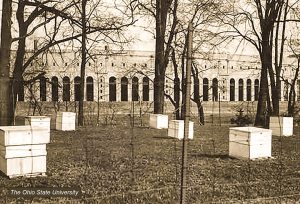
Figure 2. The Ohio State University football stadium, circa 1940s. There are no bees there today. This photo shows how much society has changed.
Multiple Ohio State University Beeyards
I don’t even know how to review all the Ohio State University honey bee program yards that have come and gone. One of the most famous was beside the football stadium. If I put bees that near the stadium today, people would freak but in the 1940’s, it was fine.
The first beeyard here in Wooster at the OSU Research Center where I worked is now a parking lot that I frequently drive past. While looking at several hundred cars in that parking lot, who would ever believe that it was once a grassy beeyard?
Reasons for giving up these various Ohio State yards. Civilization encroachment in nearly every case.
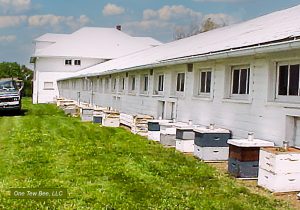
Figure 3. The Bee Barn and Beeyard in 2002.
The Bee Barn
In an earlier life, the Bee Barn was a university swine facility, and then a turkey facility. Then in its later life, and after a thorough steam cleaning, it became the Bee Barn. It had everything – even a restroom and was partially heated. It was absolutely filled with eighty years of beekeeping equipment and supplies. In 2010, a tornado utterly destroyed it – completely. Today, nothing remains of the bee barn, the beeyard or any of the equipment that it stored. It’s an open, grassy field. Nothing but memories remain.
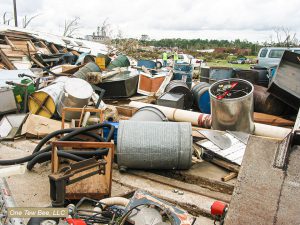
Figure 4. The Bee Barn and Yard after the 2010 tornado. Today, nothing remains but an open field.
Reason for abandoning the yard was complete destruction of the facility and the hives.
My oldest remaining yard
I have kept bees at the back of my home property for forty consecutive years. One of the primary reasons that I moved north of town was to be able to keep bees on my property. From that apiary, I have produced multiple videos, written tens and tens of articles, made several thousand photos and produced podcasts. I have sat in that yard, watching my bees, for thousands of hours. It was my haven during the covid pandemic. It was my private, quiet place.
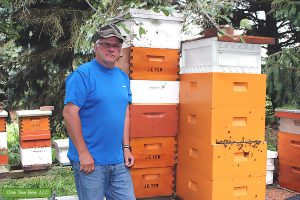
Figure 5. Jim Tew, with some of his bees in his home yard that will have to be relocated.
Now, as I have written before, within twenty feet of my colonies, a new housing subdivision with multiple housing units is being built this Summer. Heretofore, the area behind me was a soybean field. The access road to the division will be hardly ten feet from my some of my current bee hives. It does not matter that I was here long before the housing project. I will surely get complaints from construction people and subsequent home owners.

Figure 6. C. Eck and Jim Tew forty years ago (1982)
Do you recall Mr. Eck, the Wooster beekeeper, who I wrote about earlier in this piece? He had a beeyard behind his house, too – just like me but even closer to his home. The City of Wooster built a grade school on the property that joined the rear of his house.
For years, Mr. Eck, the bees and the school kids lived together agreeably. Only a wire fence separated them. Quite a while ago, Mr. Eck passed and his bees were sold. Then, recently, the school was permanently closed. A Caribou Coffee Shop stands on the location now. In this case, everything is gone – the beekeeper, the bees, even the school, but for many years, that was a hive hot-spot. I cherish the memories.
But times have changed. Now, I don’t think I can have bees so near new homes that could possibly have children – especially curious ones who go exploring. So, yes… I am making plans to move my colonies until the construction phase passes. Apparently, in my life, no beeyard location is sacred.
But again, times have changed. I am now much older. In the past, I kept 20+ colonies in my back yard – far more than I should have. But I lucked out and nothing ever happened. I no longer want nearly that many colonies there. Maybe… just maybe, I can put two to three colonies there again. I have some fencing up already and I will install even more.
So, the beekeeping humor here is that, due to aging, and passing time, I have reduced my apiary locations to only two sites. Of the remaining two locations that I now have, one is having a housing property built nearby and the other is apparently home to a roving bear that destroyed one of my colonies this past year. Readers, presently, I have zero good locations. Beeyards are weird like that. Good for a while and then not good.
Here’s the truth
If you have hung on to this point, you must have figured out that I am writing this piece for me as much as for you. I must have several hundred slides, digital photos and videos of various beekeeping events in yards that are now beeless. Most of these pictures recall good memories of bee times past.
Though not the only reason, but a primary reason for me evacuating most of the yards that I have deserted was some kind of encroachment—not just urbanization. In some instances, farmers wanted their land to put back into cultivation. For example, watermelons in Chipley and soybeans in Ohio. The Ford dealer causing Mr. Eck’s yard to be move is an instance of commercial encroachment. I am now experiencing housing encroachment.
Secondly, a common reason for giving up yards was accessibility – mainly mud and narrow gates – that would trap my bee trucks. Here’s the oddity. I have never once left a yard because of a lack of bee food sources or limited water supply or a damaging frost pocket or because my hives couldn’t be faced to the east or some such. I left all these locations because of encroachment, mud and in a single case – pesticides. It doesn’t help that I am aging. I gave up some locations for that reason. When I pass by these abandoned apiary sites, I usually have a look and think, “I used to have bees there.”
A beeyard is a bit like the circus coming to town. Lots of planning, preparation, activity and work, only then to be gone. All that remains is memories of the circus. Some yards last much longer than others, but sooner or later all beeyards give it up only to become memories for unique people like you and me.
You just wait
If you keep bees long enough, you will get your own “abandoned yard” memories, too. But shake them off. No doubt, right now you should be out in your present yard doing bee stuff. Let the future take care of itself. Thank you for reading.
Dr. James E. Tew
Emeritus Faculty, Entomology
The Ohio State University
[email protected]
Co-Host, Honey Bee
Obscura Podcast
www.honeybeeobscura.com
